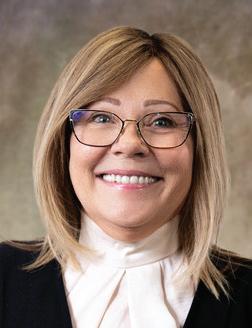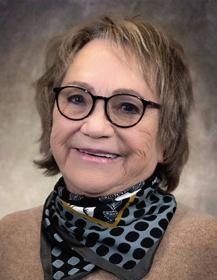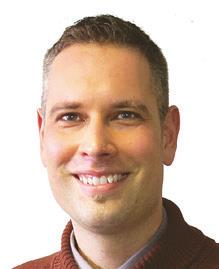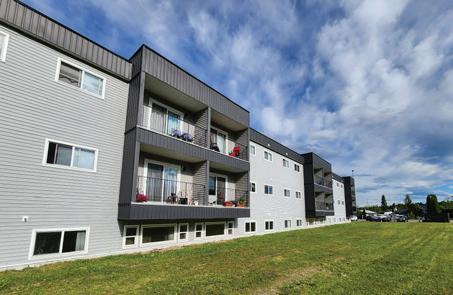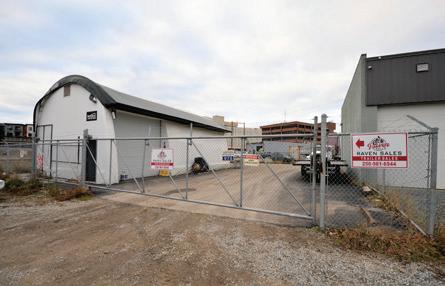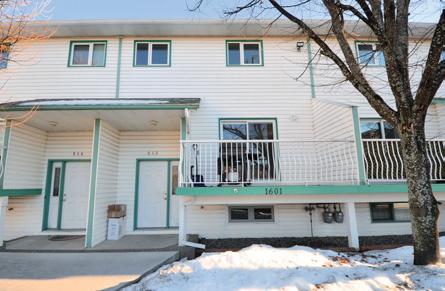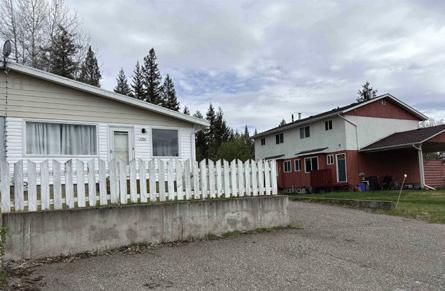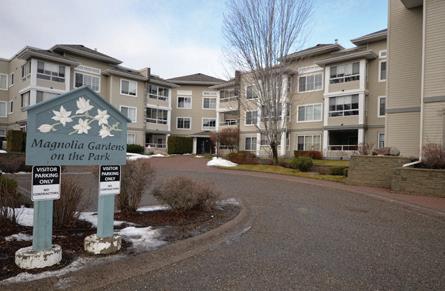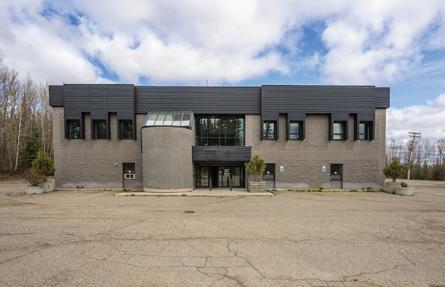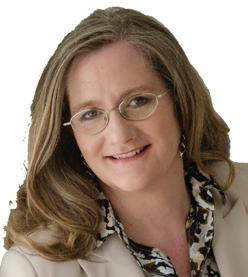




One of the country’s leading nancial thinkers visits the city
MATTHEW HILLIER Citizen Staff
Despite the global financial turmoil sparked by the U.S. president’s aggressive trade war moves, Prince George


THURSDAY, May 22,










One of the country’s leading nancial thinkers visits the city
MATTHEW HILLIER Citizen Staff
Despite the global financial turmoil sparked by the U.S. president’s aggressive trade war moves, Prince George


THURSDAY, May 22,




CONTINUED FROM PAGE 1
Cléroux spoke with The Citizen during his visit and shared the concerns and perspectives of local entrepreneurs.
“There are a lot of questions about the tariffs and their impact on the economy,” said Cléroux.
“Everybody’s trying to understand where this is going. It’s very hard to fully predict, but we talked a bit about the current impact and what we should expect for the economy in 2025.
“One of the effects of the tariffs is the uncertainty we now have in the economy. Businesses are cautious about investing, and consumers are also a bit hesitant. Local businesses are impacted if they see fewer sales than expected. Also, some are paying tariffs when they import goods from the U.S.
“This affects different sectors of the economy, including restaurants. For example, if you import certain goods from the U.S., you now pay a 25 per cent tariff. On one hand, your costs are increasing; on the other, you’re facing lower demand.”
Cléroux added that it’s not always possible to “buy local,” especially given Prince George’s northern location and the cost of switching importers. As a result, the potential impact of tariffs can be more severe.
“Sometimes it’s only on one or two products; sometimes it’s more,” he said. “That’s the impact — businesses are paying tariffs on what they buy from the U.S. Sometimes they’re able to switch to another supplier, but that’s not always possible.
“There are some products we just don’t make in Canada. For example, we don’t manufacture a lot of aluminum products. So you have to buy from the U.S., or from China — but the delays and transportation costs can be significant. It’s not always easy to switch to another country.”
Despite some “doom and gloom” predictions, Cléroux said he remains optimistic about the long-term effects of tariffs and believes more stability is ahead.
“I think the situation is becoming a
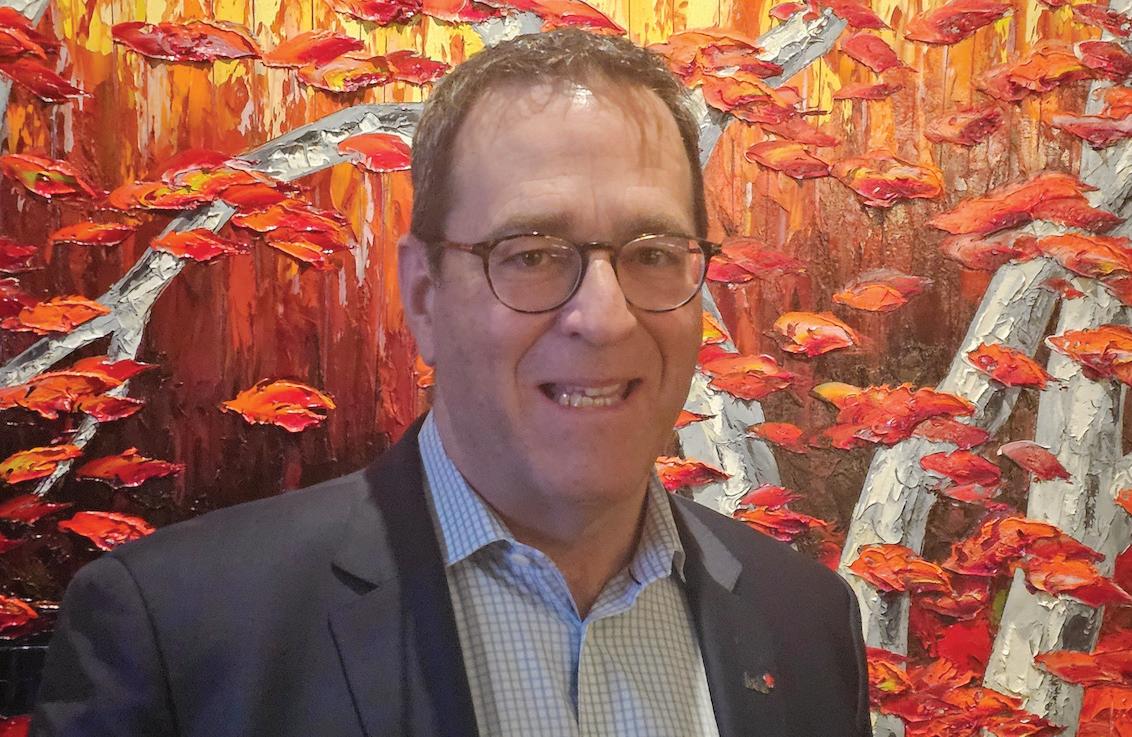
The Business Development Bank of Canada’s chief economist, Pierre Cléroux, says that despite some ‘doom and gloom’predictions, he remains optimistic about the long-term effects of tariffs and believes more stability is ahead.
bit more stable,” he said. “Consumers are starting to feel a bit more confident about the economy. It’s a bit clearer now than it was two months ago. I think this stability will benefit both consumers and businesses. Hopefully, in the next few months, the situation will improve, consumers will start spending again, and businesses will start investing again.”
Cléroux also said British Columbia — and Prince George in particular — is well positioned to recover and grow amid global trade uncertainty.
“We have to realize the Canadian and BC economies will continue to perform well,” he said.
“We have low inflation, lower interest rates, and the economy is still performing. We should feel confident — especially knowing tariffs won’t affect everything. Some sectors may suffer, but overall, the economy continues to grow in BC.
“We need to better understand and explain that reality.”
Cléroux said Prince George is particularly well placed to benefit from new investments in energy and mining.
“The economy is performing well,” he said.
“There are several investments in the mining and energy sectors that will benefit the region. Governments are accelerating these projects due to the current situation. Prince George is well positioned to benefit from this investment as a regional centre.
“The local economy is also much more diversified than it was a few years ago.”
He added that members of the Chamber of Commerce were surprised by his upbeat outlook.
“Apparently I’m a bit more positive than other economists,” Cléroux said with a laugh. “They found it interesting. This isn’t about being optimistic for
the sake of it — it’s what we see in the numbers.
“For example, the number of jobs in BC continues to increase, despite the uncertainty and tariffs. The economy is creating jobs and moving in the right direction. We’re not going to have an amazing year in terms of growth, but the economy will grow. We’re not heading into a recession. That’s why I think it’s important to share this message and explain what’s really going on — so people can feel more confident.”
When asked about his visit to Prince George, Cléroux said meeting with local entrepreneurs was a high point of the trip.
“Meeting people, meeting entrepreneurs — that’s what I enjoy most,” he said.
“To hear their stories and see how passionate they are about their businesses — that was the highlight for me.”



















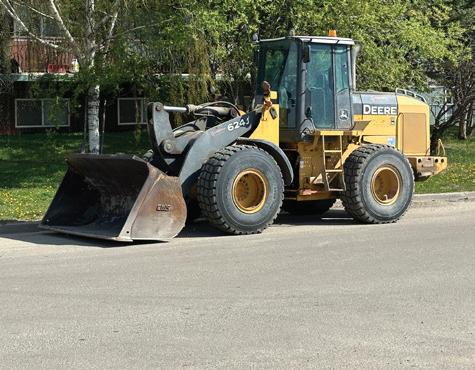











CITIZEN STAFF
Canada Post announced Monday that it has received strike notices from the union representing approximately 55,000 postal workers, signaling a possible shutdown of operations by the end of the week.
According to the Crown corporation, the Canadian Union of Postal Workers (CUPW) notified management that workers plan to begin strike action at midnight Friday.
This was the most current information as this edition of The Citizen went to press.
A work stoppage would disrupt mail and parcel delivery for millions of Canadians. Canada Post handles over two billion letters and around 300 million parcels each year.
The corporation warns that a strike would further strain its already
precarious financial position and urges both parties to prioritize reaching a collective agreement before the deadline.
The potential job action comes just days after a report recommended major reforms to Canada Post’s operations, including phasing out daily door-to-door letter delivery to individual homes, citing a need to revamp the organization’s struggling business model.
CUPW workers walked off the job last fall, with members on the picket line from Nov, 15 to Dec. 17, when they were ordered back to work by the Canada Industrial Relations Board under the direction of the federal government.
As part of the order, the CIRB ordered the previous contract be extended to May 22, 2025, putting the workers back in a legal strike position if a contract has not been reached by that date.
With files from The Canadian Press

COLIN SLARK Citizen Staff
Originally pitched as a medal program to acknowledge outstanding Prince George residents, members of the Select Committee on Citizen Recognition Program have discussed other ways of recognizing recipients at their most recent meetings.
Last year, Prince George city council voted in favour of creating an award program to recognize the good work done by the city’s residents as its highest honour, the freedom of the city, is rarely bestowed.
In 2025, council struck a select committee that is working to establish the process through which the awards will be handed out and what form the awards themselves will take.
At the committee’s April 25 and May 16 meetings, members have discussed finding a way to recognize recipients publicly.
At the May 16 meeting, members narrowed their focus on a few options. Coun. Kyle Sampson suggested that
a certain number of trees already being planted by city staff each year could be dedicated to award recipients.
According to a staff report, the city plants dozens of large caliper trees each year in locations identified to “maximize the benefits associated with increasing tree canopy coverage while adding to the aesthetics of the urban forest.”
The cost of planting one of these trees is around $2,500.
Sampson noted that at his workplace, Pacific Western Brewery, a plaque commemorating the deceased founder of the company was placed on a tree and it kept getting stolen.
In response, he said the brewery put a certificate listing the co-ordinates of the tree inside the building.
He wondered if something similar could be done for this program if issues arrive with the commemorative plaques.
For installing a bench, the estimated cost is around $2,500 and the installation window is between June and October.
The report noted that benches are
placed by the city according to operational need and there is no need for more benches or picnic tables at Lheidli T’enneh Memorial Park, Nechako Riverside Park, Cottonwood Island Park, Connaught Hill Park, Rainbow Park, Ferguson Lake Park, Hazelton Park or Paddlewheel Park.
Staff’s report said representatives from the parks department could be invited to the committee’s next meeting to discuss options.
To keep a register of award recipients, the report said possible partners could be the Exploration Place, the University of Northern British Columbia and the city’s Heritage Committee.
Other ideas floated at the meeting included engraving recipients’ names into bricks or paving stones or installing plaques acknowledging them in a public space.
Committee member Chantelle Grafton wondered whether a park still in the development stage could be designated as the area where the commemorations can be placed as they’re awarded.
Manager of event services Debbie
Haywood noted during the meeting that the Novak Family Legacy Wall installed in the lobby of the Prince George Civic Centre lobby in 2014 as a fundraising initiative for the 2015 Canada Winter Games is being proposed to move to the atrium of the Kin Centres, though that process is still in the early stages.
Also discussed briefly were sample budgets for annual events where the award recipients would be celebrated.
A casual event with 500 attendees is projected to cost $20,400, with $2,500 in entertainment costs, $5,000 for audio-visual services, $400 for swag, $7,500 for food and facility rental and $5,000 for the awards themselves.
A formal event with 200 attendees is projected to have $30,400 in total costs, with $2,500 going to entertainment, $7,500 for audio-visual costs, $400 for swag, $15,000 for food and facility rental and $5,000 for the awards themselves.
The committee’s next meeting is scheduled for 10 a.m. on Thursday, June 26 in the second-floor conference room at Prince George City Hall.
COLIN SLARK Citizen Staff
With a few pen strokes, the City of Prince George officially became the first local government to join the Human Trafficking Prevention Network of British Columbia on Friday, May 16.
Mayor Simon Yu and councillors Garth Frizzell, Trudy Klassen, Ron Polillo, Kyle Sampson and Susan Scott signed a statement of support denouncing trafficking as a human rights violation and committing to work towards ending it.
“As we recognize the victims and survivors of crime week, we take meaningful steps towards this very serious issue together,” Yu told a small crowd on the second floor of city hall.
The network was first formed in 2024, with former Lt.-Gov. Janet Austin serving as its honorary patron and Shell Canada serving as the body’s chair.
Other partners include the BC Lions football team, All Nations United, the BC Native Women’s Association, the Business Council of British Columbia, KPMG, the Royal Bank of Canada, the Canadian Centre to End Human Trafficking and more.
Prince George’s Standing Committee on Intergovernmental Affairs heard at its April 1 meeting that the city’s application to join the network had been accepted.
Last July, city council passed a motion declaring both intimate partner violence and human trafficking as local epidemics.
The statement of support signed on May 16 also said that as a member, the city will work to understand and collaborate to address human trafficking’s root causes.
It also noted that First Nation, Métis and Inuit people as well as two-spirit and gender diverse people are disproportionately victimized by human trafficking.
Before the signing, the mayor said that the city’s support for the network is more than just symbolic and it will partner with other governments, non-profits and people with lived experienced to
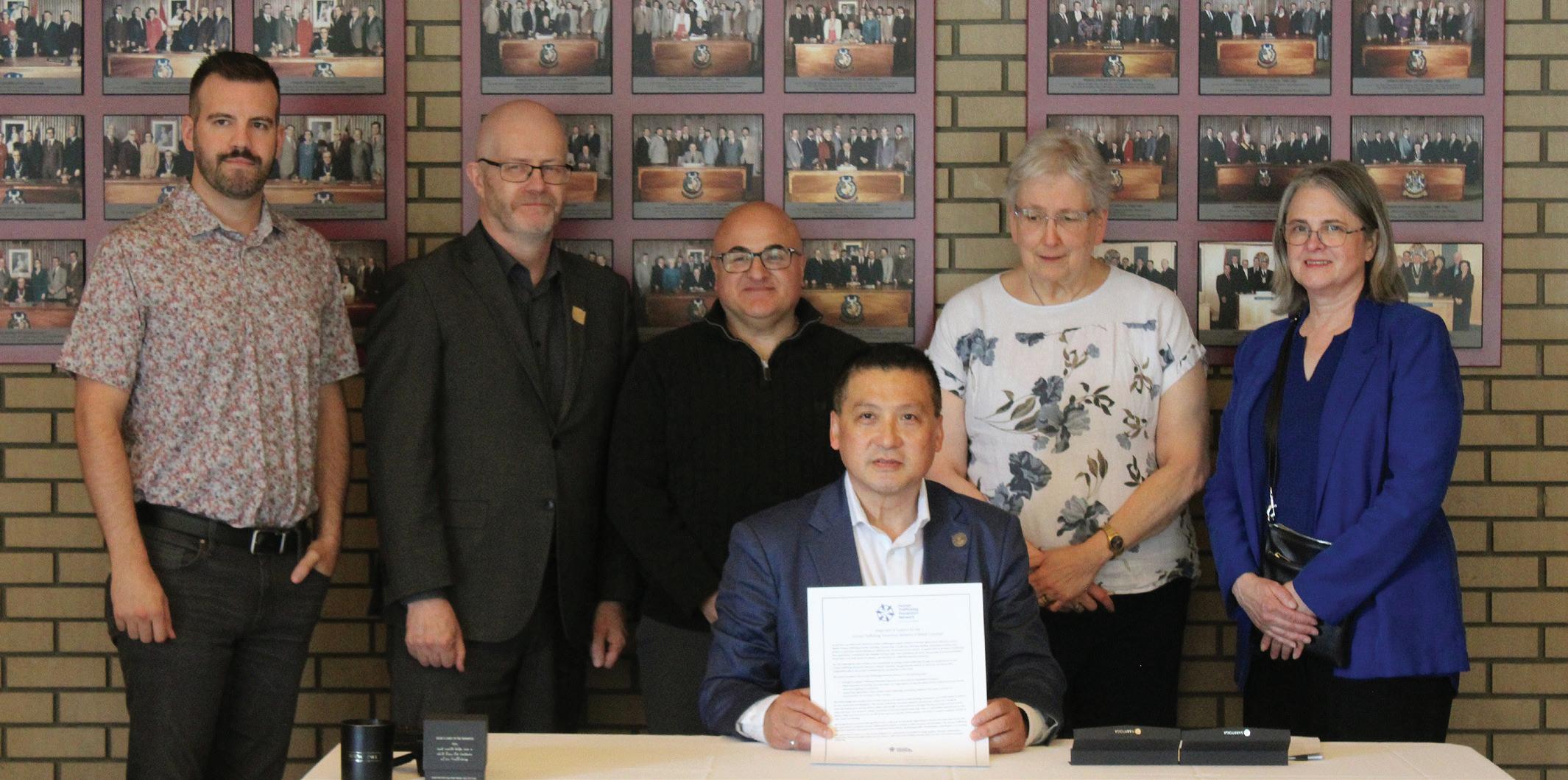
After the signing, Yu referenced the shooting of a 15-year-old girl at Moccasin Flats earlier in the week.
While he said he hadn’t heard that incident was connected to human trafficking, he doubts a teenager woke up one day and decided to live in a “random trailer down in the place where there’s no running water, no food.”
He said it’s a symbolic issues he’s using to make locals aware of people like immigrants, First Nations or other groups who can be placed into situations where they are exploited due to financial circumstances.
“As a city, as a part of the international community, we needed to get the work to prevent things like that from happening not just here but throughout the world,” Yu said.
“This signing is symbolic to make people aware that this sort of human trafficking issue is happening. It can happen in your neighbourhood as well.”
The first step, he said is to raise awareness and after that support groups need to be developed. Yu pointed to efforts against human trafficking launched by the Prince George
International Airport earlier this year as one example of local work being done.
The mayor said he hoped Prince George would set an example for other local governments to follow and that the city had brought human trafficking up during last week’s North Central Local Government Association annual general meeting in Prince Rupert.
Those attending the signing included Prince George-Mackenzie Conservative MLA Kiel Giddens, Prince George and District Elizabeth Fry Society executive director Shannon Smith and Grace McLaughlin, the Indigenous-focused sexual assault response worker at the Prince George Sexual Assault Centre.
Speaking to reporters after the signing, Smith and McLaughlin said the city’s support was huge for both giving recognition to the work their organizations carry out and raising awareness about the challenges of dealing with human trafficking.
“We are hoping to have more of a community approach rather than just leaving it to the organizations,” McLaughlin said. “I think it’s important that the city gets involved.”
“And also to have the city to use their connections, right?” Smith added. “Because they are at many provincial (and federal) tables that we are not. If we can use all the strengths and the pieces that we have to bring this issue forward, I think the more that we can work together.”
They said the impacts of human trafficking are felt in Prince George by the survivors who visit them for support, but also by people who have been trafficked and may not even realize it.
“We need to be thoughtful of those folks and how can we best use our connections, use our voices to help support those people,” Smith said.
Following the signing, city representatives and representatives from the Association Advocating for Women and Community, the Elizabeth Fry Society, the Prince George Sexual Assault Centre, Violence Against Women in Relationships (VAWIR) Committee and Carrier Sekani Family Services Sexual Violence Survivor Support Program went into a conference room for a round table discussion on human trafficking.

Visitors can attend for FREE using promo code CNRE2030 or scan the QR code
TED CLARKE Citizen Staff
Build it and they will come?
Tanya Spooner, the city’s manager of emergency programs is hoping they won’t have a reason to be there.
But if any people are forced to evacuate their homes due to wildfires in the region, the Emergency Support Services Reception Centre will be there to welcome them.
The complex of three Atco trailers and a dedicated washroom facility has been set up in the Kin Centre parking lot next to Kin 2 and city staff will be ready in case there is an emergency evacuation, with the fire season just beginning.
The complex will serve as the co-ordination centre for the city’s response efforts to wildfires or other natural disasters to provide people forced out of their homes with access to hotel accommodations, campgrounds, meals, clothing, animal protection and whatever city services they require.
Evacuees who have a BC Services profile already set up on their mobile device would receive a cash disbursement directly deposited into a bank account and how they spend that money would be left up to the individual.
Those without a device would get a voucher for accommodations or groceries at the reception centre.
This is the second year the trailers are at the current location since it was assembled last year as a pilot project for the rest of the province. The city pays to set up and dismantle the centre and to train the 24 part-time staff of about 24. The province will be responsible for operational costs and rental of the trailers.
“We learnt a lot last year and we’ve made some changes to our setup this year,” said Spooner. “The main trailer for where evacuees can come and be registered (and now has five reception stations) can have up to 10 kiosks at a time if needed.
“The ultimate goal remains a more permanent solution. However, Prince George has been asked to support neighbouring communities time and time again, and having the trailers in place and operationally at the ready means that we are ready not only for whatever is in store for PG, but whatever is in store for our region.”
Last year the Prince George centre was busy in May, then went into a lull until July, when the Jasper wildfire brought dozens of evacuees to the city. Spooner said the centre serves a vast area that covers two-thirds of the province with people from as far south as Lytton and 100 Mile House potentially being directed to the city in the event of wildfire.
“That is the reality of the northern part of the province right now, it doesn’t need to be in Prince George any more,” said Spooner.
The centre has a capacity of processing about 1,000 people per day. In the event of a mass evacuation like the Williams Lake fire that brought 10,000 people to Prince George in July 2017, Spooner said one of the adjacent arenas would be utilized.
“One of the big things we have focused on is moving people through the system with care and compassion but as quickly as possible because, ultimately, getting people back out and living their lives is far more beneficial for them in their recovery that sitting in the reception centre,” said Spooner.
“As soon as they have control back and start making their own decisions they can start making their own plans and are not standing in line. That’s of benefit to them and it’s a benefit to us as well. We’re longer doing the reception centre that you saw in 2017, we don’t have on-site daycare and you don’t have people congregating in the space anymore. It’s a place for them to come, fill out the paperwork and then they can go out and live their lives.”
In recognition of the Indigenous communities one of the trailers has been designated for cultural activities.
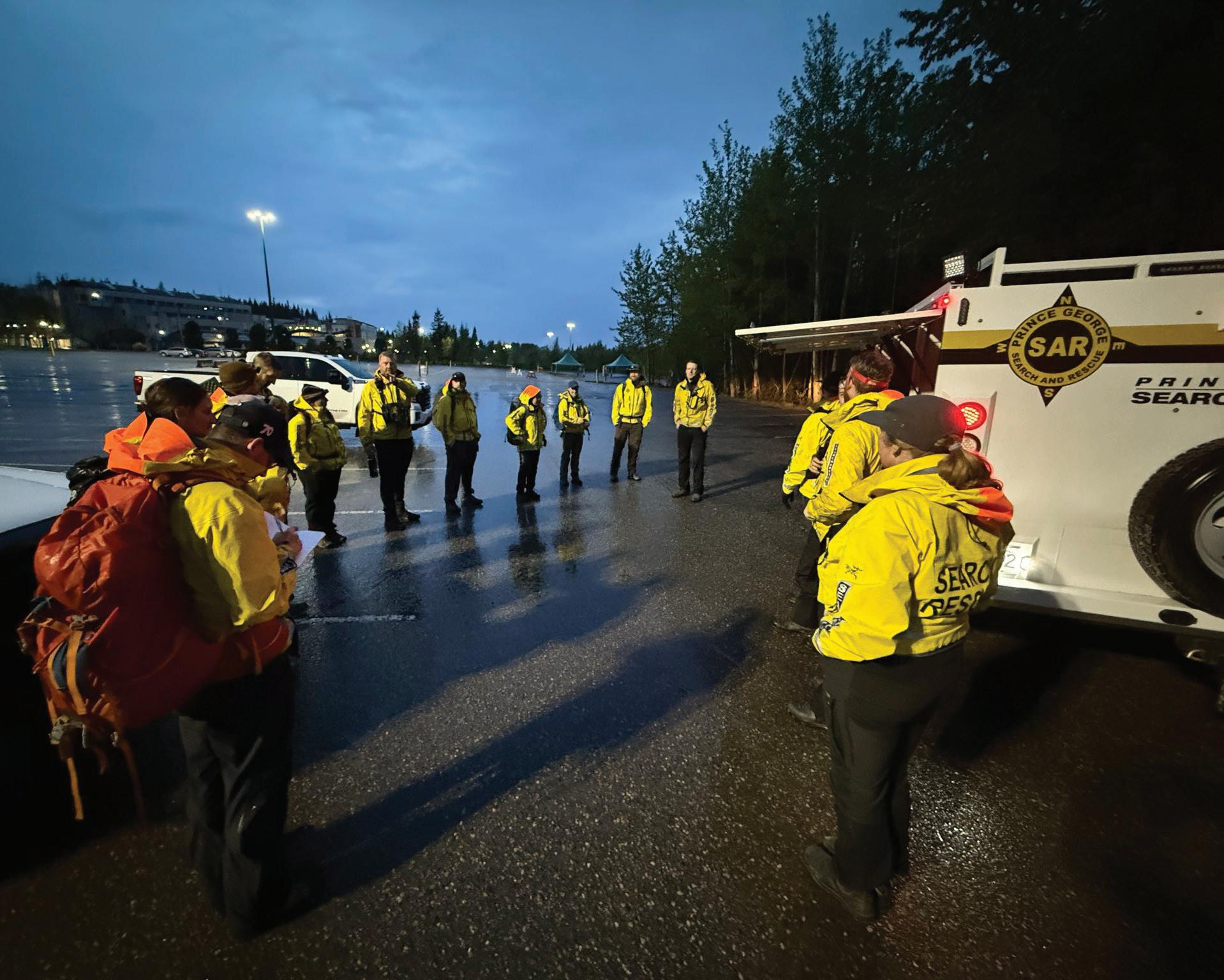


KENNEDY GORDON Citizen Managing Editor
Since its founding more than 110 years ago, the primary purpose of the Prince George Chamber of Commerce has been to support and promote local businesses.
Its own website identifies its purpose as striving “to connect, engage and enhance quality of life in our community.”
That mission has always been essential. During the uncertainty and shifting economic climate caused by the tariff policies of the United States, the Chamber’s support for local businesses is even more critical. In times like these, Prince George and our region’s economic resilience should be the Chamber’s top priority.
Neil Godbout, executive director of the Chamber since 2024, shares these sentiments through the Chamber’s newsletter stating: “When we shop local as much as we can, we all win,” and highlighting the importance of a “Team PG approach.”
It’s why we find his latest decision so troubling.
Through a three-year contract awarded without a tendering or RFP process, the Prince George Chamber’s upcoming membership guide — a glossy, full-colour magazine designed to spotlight its business membership — will be produced not by a local firm, or even one in British Columbia, but by a company back east.

We are glad that the business is going to a Canadian company. However, we know there are local options available, including our own publication.
The Prince George Citizen has a long and proven track record of producing high-quality, glossy publications this eastern company will now be delivering. Leadership at the Chamber are keenly aware of this fact as two key positions are held by former editor (Godbout) and a former publisher of The Citizen. Having produced such products during their time at The Citizen, they know exactly what we, and other BC firms, can do.
So why the out-of-town and out-ofprovince choice? We can’t speak to this decision as we were not included in the process.
To some, this criticism may sound like sour grapes. We’ll admit it: we would have liked the business. But that doesn’t make the concern any less valid.
In fact, it’s precisely because The Prince George Citizen is a founding member and supporter of the Chamber for more than 110 years that we would like to
have partnered with the Chamber.
Chamber members have been receiving phone calls and emails from this eastern firm and money from Prince George businesses is being redirected both out of our city and out of our province.
Those dollars could have gone to support jobs here, pay local writers and designers here and promote the very economy the Chamber claims it is here to defend.
With The Citizen’s new local ownership, we’ve worked hard over the last year to source locally. We think supporting local businesses is crucial.
Godbout, as the executive director of the Prince George Chamber, claims the same, but he needs to start leading by example.
When the Chamber chooses to look outside its own community and province for services that are clearly available, it’s telling Prince George businesses that only your membership dues matter.
That is not the message any business wants to hear from organizations
asking for their membership, receiving their money, and operating advocacy committees.
Faced with increased trade restrictions and pressures on our forest industry, businesses are rightly looking inward — not to retreat from the world, but to support homegrown expertise, build economic self-reliance, and strengthen local supply chains.
This is not the first time we have faced disruption to the supply chain, and not always due to international relations, such as the Atmospheric River Event of 2021 which isolated Northern BC.
The “shop local” message continues to resonate, especially with those of us in Northern BC who are known for supporting each other.
Local chambers should be at the forefront of that effort. Ours needs to return to its roots. This isn’t just about one contract or one publication. It’s about trust. It’s about a commitment to enhancing the community.
Can local businesses trust Godbout and the Chamber to prioritize them when it matters?
Every local business, and especially members, should expect their support.
The Chamber’s success is directly tied to the success of its members. It’s an organization that needs to be championing our community above all else.
The Prince George Chamber should be playing a pivotal role in that and leading by example.
Have your say on this with a letter to the editor: editor@pgcitizen.ca.
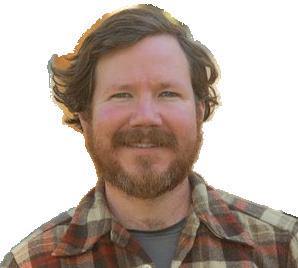
A historic piece of iron sits in the corner of my dad’s shop.
It was the original lathe at Clear Lake sawmills where my dad was a machinist for 25 years. Between that old “engine lathe” and the cast of characters who ran the Clear Lake machine and fabrication shop, it helped Clear Lake make a name for itself.
One of their claims to fame was being the first mill to get an operational holedriller set up on the chain, a wily way around the softwood lumber tariffs. By drilling a hole in every stud for electrical wiring, the 2x4 became “value added” and was no longer subject to the softwood lumber limits. Truckload after truckload of pre-drilled studs left Clear Lake to circumnavigate the tariffs.
Not everybody thought it was so great.
Years later, at a graduate seminar I attended at SFU, one of the negotiators of the Softwood Lumber Agreement singled out those damned pre-drilled studs for pissing off the Americans and deep-sixing the agreement’s renewal back in 2001.
“Then some hillbillies up in Prince George came up with pre-drilled studs” I remember him saying. Maybe he didn’t use the word hillbilly, but it was something along those lines.
I couldn’t help but open my trap and brag about how that was my dad and his buddies who came up with the hole drilling contraption.
But sitting in the background of that story was that old lathe.
Built during the Second World War by the R. McDougall Company in Galt, Ontario, it’s production was in many ways the last gasp of Canadian manufacturing prowess.
From the late 19th century until the

post-war era, Canada had tariffs and policies in place to ensure we had manufacturing capacity.
And not just the ability to produce things, but the ability to produce the tools necessary for production — the machine tools.
Between the industrial hubs scattered throughout Ontario and Quebec, and even Winnipeg, Calgary and Vancouver, Canadian industry manufactured locomotives, heavy equipment, tractors, ships, and most importantly- the machines to make them.
The national policy that gave birth to what is now my dad’s lathe was borne out of what we are now experiencing: fear of the United States.
In the 19th century there was a lot of concern with American imperialism, there were violent border skirmishes even, and one of the hedges against American expansionism was ensuring Canada had domestic machine-tool capacity.
That industry, pushed along with demand from a massive railway network, laid the groundwork for the rapid expansion of Canadian manufacturing during the Second World War. Canada rose from a global backwater to the fourth-largest industrial producer amongst the allies, and probably
seventh worldwide after Germany and Japan.
Borne out of that explosion of activity, rumour has it the old lathe took on a post-war life manufacturing desktop globes, back when we still made stuff like that in Canada. Later, it ended up at Clear Lake Sawmills.
Now, even that industrial legacy is fading behind us. Clear Lake and the many other small mills that drove Prince George’s prosperity have been torn down and shipped out. The R. McDougall Company, it goes without saying, has long since gone out of business.
Now I notice that Ireland has overtaken Canada in its manufacturing capacity.
Despite Pierre Pollievre trying to pin this on the Liberals, Canadian manufacturing has been in steady decline since we abandoned our nationalist economic policies at the end of the second world war. This accelerated under the Progressive Conservatives and Brian Mulroney’s Free Trade deal, a deal which, to their credit, the Liberals campaigned against in the 1988 election.
Now both parties are indistinguishable: both promise free trade, endless sums of money for port infrastructure, open borders to cheap offshore goods, and an unflinching commitment to
turning Canada into a dumping ground for Chinese and other offshore manufacturers. They are equally in cahoots in their quest to turn Canada into an extraction zone of cheap minimally processed goods for the global manufacturing powers to exploit, whether that is raw logs, oil and gas, coal, or minerals.
The worst out of all these dead-end economic strategies has been oil and gas. Despite mixed signals in the last couple years, the massive growth of this sector- we are now the 4th largest oil exporter in the world- has effectively turned Canada into a petro-state with a petro-dollar that has helped further undermine our manufacturing sector.
I don’t expect our oil and gas lobbyist/ politicians or our oil and gas invested financial sector to say anything about this when they complain about the loss of manufacturing, but I’d encourage readers to learn about “Dutch Disease.”
Despite Mark Carney’s denials, that’s what Canada’s got. The growth of oil and gas lines up pretty closely with the quickening decline of manufacturing, and a lot of this has to do with the petro-dollar pricing out our value-added exporters.
Taking the path of least economic resistance has been our newfound national policy: buy cheap offshore products and sell off our resources for pennies on the dollar; do nothing to support domestic self-sufficiency and manufacturing and do everything for the entitled oil and gas elites.
But that old lathe in the corner of the shop tells me that’s not how we built this country.
We built it through manufacturing and self-sufficiency. We built it using our brains and our instinct for self-preservation and our desire to add value. We built things we could be proud of, not this flimsy sell-out economy we now have that exposes us to the whims of global uncertainty, the product of generations of clueless elites and selfish neoliberalism.
James Steidle is a Prince George writer.
Council looks to reduce snow removal budget: What option would you like to see?
I didn’t like any of the options presented in this survey. Too many unnecessary trucks and plows in our area over the last 2-3 years. A “Make Work” look to it. No work, lay them off. Simple.
Survey options:
1. Don’t touch the budget.
2. Focus on priority routes & ignore residential routes on STATs
3. Increase the budget — snow clearing could be better in PG. There should be a 4 and 5th option.
4. Reduce budget and use internal equipment by lowering the service level.
5. Lower the service level and ban OT, lowering the budget. Simple and efficient.
CC Mail

Committee members wary of discussing grant funding in front of Citizen reporter
It is important that any public office keep everything transparent and above board so having members of the public and media there keeps the process fair. This is especially true when discussing anything around money whether it be collecting, spending or increasing/ decreasing fees and so on because we have the legal right to know how public officials are spending or collecting these monies.
If you feel uncomfortable with having media there then it sends a message that you don’t want things known.
Dearth
Committee members wary of discussing grant funding in front of Citizen reporter
Very strange. What is the difference between members of the public attending a public meeting and a Citizen reporter, there to inform the public at large? In this age of “transparency,” where is this fear coming from?
Fred Vinson
Committee members wary of discussing grant funding in front of Citizen reporter
I wonder why the former CEO of The Exploration Place wants these meetings to be behind closed doors? This is very suspicious considering the state of finances The Exploration Place is in.
CC Mail
Letter to the editor: The last thing you want is a chicken coop in your yard
I had chickens in New Westminster.
Weekly cleaning of the coop and waste to the city’s recycling or home use of waste made it all manageable. New Westminster allows up to 10 hens but the yard and distance from other houses are monitored.
It was an absolutely wonderful experience.
My grandchildren played a huge part. We joined the closest 4H club in Langley. My grandson brought a couple to school for a class presentation.
Madeleine LeBlancReiser
Letter to the editor: The last thing you want is a chicken coop in your yard
Something people are not considering is why do people want chickens in their back yard anyway.
If you are wanting meat birds or layers, you still need to pen them in a coop. They will create waste regardless of how long you have them.
Chicken waste builds up! What are you going to do with it. Chicken waste creates methane gas and is very strong. Chicken waste does not break down into compost over night. This is an issue that will become a problem for residential owners.
I would think that a lot of people that are in favor of this have never lived on a farm Northern Logger
Northern health area one of the highest for toxic drug deaths in February, March

The funny thing is, they believe it’s all helping, but the statistics are clear, it’s a run away train and people are paying with their lives.
I believe in a decade or two, when the dust settles and their are 10s of thousands of people who were enabled to continue the cycle of drug addiction, resulting in a trail of carnage, leaving people dead or brain injured, there will be a massive class action lawsuit to pay for damages as a result of these moronic policies.
The sick thing is, it won’t be the people that created and administered these policies paying the price, it will be you and me.
Pretty sad when you have medical professionals, veteran police officers and former addicts sounding the alarm bells and our elected officials ignore them. Zangief Share your views on our stories at

COLIN SLARK Citizen Staff
School District 57’s board of education decided to pass two of three readings of the bylaw setting its proposed $212.8 million budget for the 2025-26 school year at its Tuesday, May 13 meeting, leading Supt. Jameel Aziz to express frustration over the process being slowed down.
A special meeting has been called for Tuesday, May 27 to consider third and final reading of the budget bylaw.
At the start of proceedings, the draft budget featured an operating fund worth around $180.7 million (85 per cent of the total budget), around $22 million in special purpose funds (10 per cent of the budget) and around $10 million in capital funds (five per cent of the budget).
As the board entered discussion into the budget in Mackenzie on Tuesday, May 13, unanimous consent was denied to a motion that would have seen all three readings of the bylaw passed that night.
Under section 68(4) of BC’s School Act, a board of education may not pass all three readings of a bylaw at a single meeting “unless the members of the board who are present at the meeting unanimously agree to give the bylaw all three readings at that meeting.”
After the motion was introduced, Trustee Sarah Holland said she didn’t want to be the lone person holding up its adoption, but that she had questions she wanted answered before the budget was passed.
With the meeting being livestreamed from the library of Mackenzie Secondary School, it was unclear on the video feed which trustees denied unanimous consent though at least two put up their hands in opposition.
When trustees started to ask questions after the passage of the bylaw’s first reading, Aziz said he was “extremely disappointed” that unanimous consent was denied.
Last year, he said, they had a conversation that the budget process needed to be in place earlier so that the district could get its operations in order and
this decision essentially put that on hold.
“I just wanted to put that on the record and state that, because now, again, all the work by staff is essentially being disrespected,” Aziz said.
Responding to Aziz’ comments, Trustee Rachael Weber said while she believes that senior administration did “exceptional work” on developing the budget, the board and individual trustees still had outstanding questions and she wasn’t comfortable with passing all three readings that night as a result.
The draft budget includes cost reductions due to the closure of Giscome Elementary School at the end of this school year and the closure of the Central Interior Distance Education School in January 2026, secretary-treasurer Lynda Minnabarriet said while presenting on the budget’s broad strokes.
Regarding CIDES, $105,000 worth of prior-year surplus funds received as grants will be used to cover the cost of course completions until the program ends.
She said it also includes a $250,000 increase to the capital budget for facilities maintenance, asphalt repair or interior heating as well as salary increases for both unionized and non-unionized employees.
With collective bargaining underway, the full impact of salary increases on the school district’s budget is not yet known.
Another addition is a vice-principal position in Mackenzie.
The capital fund for 2025-26 includes $650,000 received from the provincial government to carry out heating, ventiliation and air conditioning work at Beaverly Elementary as well as $625,000 for similar work at École College Heights Elementary.
Both Aziz and Minnabarriet talked about a projected decline in enrolment the district will see over the next three years.
In the 2024-25 school year, there were 13,269 students enrolled in School District 57. In three years, that figure is expected to decline to around 13,000 Minnabarriet said that of the

operating costs, around 88 per cent or $160 million go towards wages and benefits for employees.
Budget documents show an increase in expenses relating to leases. That, Minnabarriet said, is from the district transitioning away from buying technology equipment to leasing it.
The draft budget proposes to transfer $299,841 from the district’s operating funds to capital funds to help replenish capital reserves. Those funds are used to address capital needs not funded by the provincial government like technology infrastructure, facility equipment, vehicles and portable classrooms.
Responding to a question from Holland, Aziz said because of that projected decline in enrollment and the corresponding drop in revenues, administration wants to make sure it has money in its savings account for emergencies like boiler or roof replacements.
“We actually have a very low capital reserve fund based on our overall district operational dollars as compared to most school districts across the province,” Aziz said. “We have obviously utilized those funds for a variety of things over the last number of years and it was really important that we replenish those funds. We are not sacrificing any students’ education program environment.”
A report from district administration noted that the financial impact of U.S. tariffs on capital projects and purchases are still unknown.
After working hard the last two years to make tough financial decisions,
Minnabarriet said, there’s a small amount available for the district to reinvest into facilities.
“School District 57 is not unique to this, but as people look to cut they try and cut the places that they feel are furthest away from the classrooms and students, so things like carpenter positions, the money that the board would invest in painting, paving, all of those things have been reduced and our fear moving forward is if those cuts continue, your facilities will decline,” she said.
Trustee Shar McCrory asked about a letter from CUPE Local 3742, which represents support staff at the school district, arguing against planned cuts to lab technician positions. She said she hadn’t been aware that any job cuts were on the table.
“My question back to staff would by why are we cutting positions when we’re in a surplus position and why are we cutting positions that directly affect students?”
Aziz responded that lab technician positions haven’t existed in most school districts for the last 30 years.
“Teacher prep work is the work of teachers, it’s not the work of CUPE and so our principals collectively when they looked at the operations of their schools made the recommendation that those positions should be eliminated,” Aziz said.
“Nobody is losing their job. The actual job that they have may be a different job, just like we have looked at all sorts of efficiencies across the school district because we have to make decisions around the best places to spend those dollars.”
Other items of discussion on the budget included the use of surplus funds to replenish the district’s capital reserves, the potential reassignment of lab technicians at high schools to other positions and the work the district has done in the past couple of years to improve its financial position.
The special public meeting on the third and final reading of the budget has been scheduled for 6 p.m. on Tuesday, May 26 and will take place virtually via Zoom.







‘Mayor of Moccasin
did it all for his daughter
TED CLARKE
Hank Hayden found his calling in life the day he became a father. It was Jan. 4, 1992 — long before he became the unofficial “Mayor of Moccasin Flats.” Soon after his daughter Tamara arrived, Hank decided he no longer wanted to be away from his family, working in remote camps as a driller, carpenter and first-aid attendant. He ditched his transient lifestyle so he could watch his daughter grow up and take care of her — a commitment he honoured until the day he died on Dec. 8, 2024, of an overdose in his tent at the notorious downtown Prince George homeless encampment.
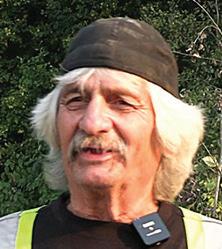
here to look after Tamara.’”














“Hank had such a big heart for people, and I have never met such a dedicated, committed dad. Nobody holds a candle to him. When I think of all the dads that I know — he was the best,” said retired social worker Diane Nakamura, among the crowd of about 200 who attended a noon-hour Healing Fire tribute to Hank on Wednesday, May 14 in front of the Prince George Courthouse.
“He had such a love for people, and he had a child — a daughter — he loved unconditionally, and that’s just who he was. Tamara put him through the wringer and made him run, and he never, ever gave up on her. I saw that in his dealings at Moccasin Flats. That was a very hard life for him, but he was so dedicated to helping people.”
Hank established himself as a dependable worker in whatever job he took on — diamond drilling, construction, bartending or youth counselling, a role he especially took to heart.
“He always had a decent job, and I was shocked when I saw him at Moccasin Flats and asked what he was doing there,” Nakamura said. “He said, ‘I’m
Hank held a Level 4 industrial first-aid ticket and was the person everyone in the camps turned to for help. He treated infections and frostbite, stitched up knife wounds, picked buckshot out of shotgun injuries and delivered almost daily naloxone shots to prevent overdose deaths. He saved dozens of lives. He also offered guidance to a pregnant woman whose addiction had left her rejected by aid agencies. He discouraged teens from setting up tents, knowing how vulnerable they were, and connected them to support services. He boiled artificial respiration masks used on overdose victims so he could reuse them — he couldn’t afford replacements — until former Camp Trapping director Alan Huggett found a local agency to provide new ones and a digital oximeter to help him detect heartbeats during CPR.
“Hank was often frustrated that the city and many citizens weren’t seeing the full picture of the homeless situation,” Huggett told the crowd at Wednesday’s gathering. “He saw the behaviours associated with addictions and poor mental health as the result of deep, trauma-based psychic pain.
CONTINUED FROM PREVIOUS PAGE
“Hank wanted to find ways to bring the homeless and the rest of the citizenry together to reduce the stigma of homelessness. He wanted the city and the province to stop treating poverty as a criminal issue. We’re still working on that, Hank.”
When Huggett met Hank, Daryl Goll was working as executive director at Camp Trapping, a wilderness camp south of the city for young offenders started by parole officer Bruce Hawkenson and his wife, Joanne, in 1971. For 50 years until its closure in June 2021, the camp offered a court-ordered alternative to jail for up to a dozen boys aged 12 to 18.
At about 30, Hank was familiar with the dangers kids faced on the downtown streets. Encouraged by Goll, he enrolled in the Front Line Youthcare (FLY) worker course while still working as a gold miner.
“He was blown away by what he learned and realized he was highly effective with street people,” said Goll, now a youth social worker with Intersect Youth & Family Services. “I’d taught a lot of people, but never saw someone take to it like he did. As a result, I invited him to Camp Trapping to work weekend shifts.”
Though nervous at first, Hank soon connected with some of the First Nations youth.
“He was like a deer in headlights,” Goll said. “But after a couple of chats, he started becoming highly effective. It was spectacular, really.”
Though Hank wasn’t keen on strict rules or group counselling, he thrived in one-on-one mentorship. His knees struggled with the daily six-kilometre runs, and after six months, he left Camp Trapping and never formally worked as a youth counsellor again. But he never forgot the experience, using those skills the rest of his life.
“Hank was vital to a couple of kids I worked with who were involved at Moccasin Flats,” said Goll. “Through him, I got the word out that they were off-limits and nobody should sell them anything. Next thing you know, the kids would come to me saying, ‘I can’t score.’”
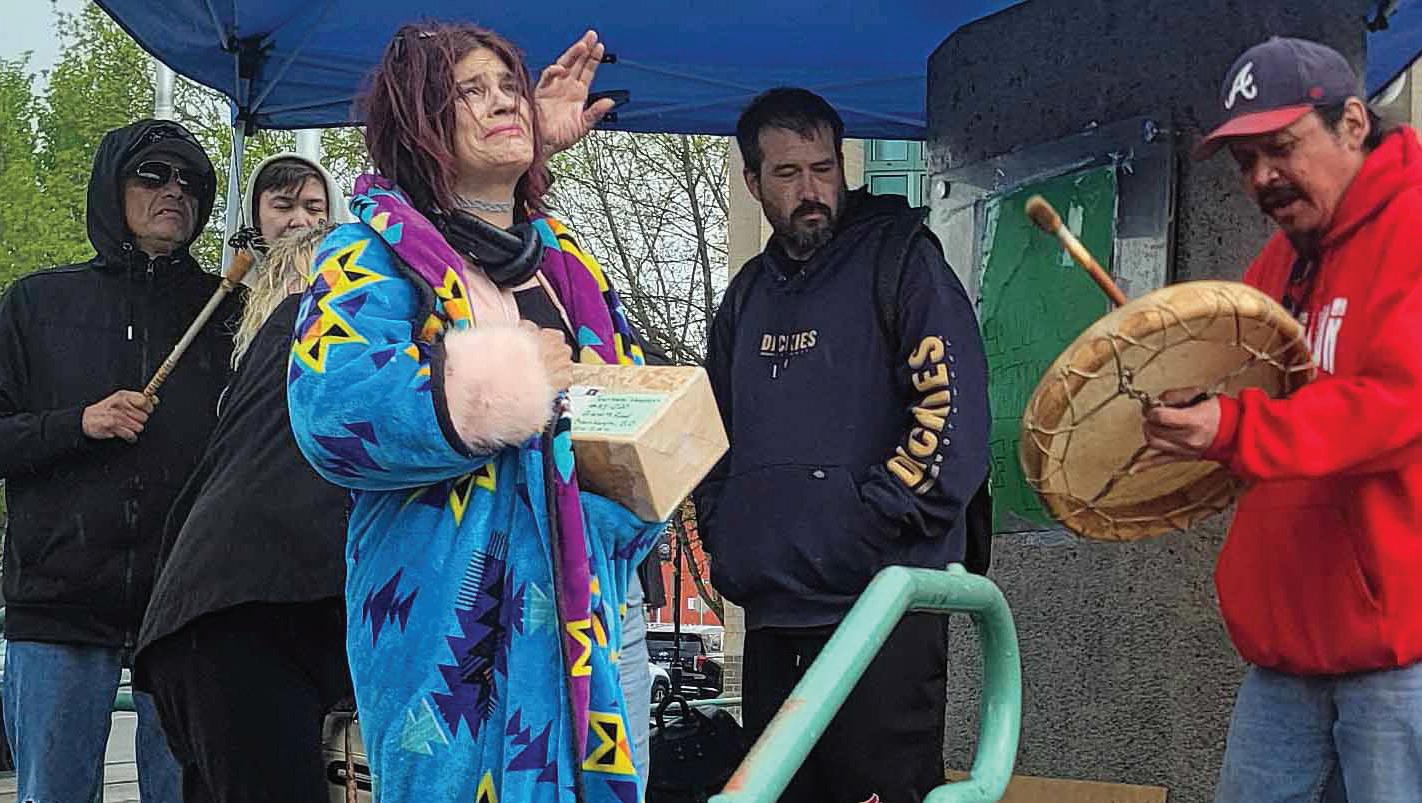
It didn’t always work. Three summers ago, when close to 100 people were camped at the Flats, one of Goll’s clients — a 14-year-old boy — was found dead in a dumpster after an overdose.
“I was shook to the core, and Hank felt bad too. We did our level-headed best to prevent it, but couldn’t,” Goll said.
Hank loved the party lifestyle and had a reputation for making people laugh. He also struggled with substance use. Two years ago, he overdosed on fentanyl at the former Connaught Inn motel and was revived with naloxone.
“He talked about it like it was just business as usual — that freaked me out,” said Goll. “I said, ‘Hank, you could have died,’ and he just smiled. He said it was so cool to see his own body. You’d think he would learn.
“I never got over the fact he was playing both ends against the middle. He would work all day to repair people and then go to his tent and use. I said, ‘That’s no way to live.’”
Hank was known as part of the “welcome wagon” at the camps, offering newcomers a safe haven. He was the link between residents and city council,
city staff, Prince George Fire Rescue, RCMP and social agencies. Just before he died, he was preparing to launch a podcast called Voice from the Tent, to be recorded at Moccasin Flats. Huggett helped him form a non-profit organization: Building a Healthy Community Society: The Voices Project.
“Hank saw it helping all of Prince George be healthy — not just the homeless,” Huggett said. “The Voices Project was to give the unhoused a voice. Hank worried shelters were being built just to meet court orders, not the real needs of people. I hope we can prove him wrong.”
As much as he cared for everyone in the camps, Tamara was his world.
He was proud of her and worried constantly, knowing her own struggles with addiction and the dangerous people she sometimes encountered.
All he wanted was for her to find peace and happiness.
Years ago, Tamara fell in love with a high-ranking Hell’s Angels member. Hank followed her to Edmonton and attended club activities to keep her safe.
“He was always there for her until she was ready to go,” said Goll. “If she
wanted to stay, he stayed — talk about going the extra yard.
“I can’t knock Hank for that. That is so righteous. If half the people had as much love for our kids, we’d chase them all over the place too.”
Years of living at Moccasin Flats, Millennium Park and near the courthouse, and facing gut-wrenching situations — like the night he put himself between Tamara and a man with a loaded pistol — wore him down.
Goll urged him to return to his roots with the Nuxalk Nation in Bella Coola, where he had been raised in a foster home with 16 kids after being adopted as a baby during the Sixties Scoop.
“I sensed Hank was slowly burning out,” Goll said.
“The constant strain of living down there — it was all just welling up in him like a bad smell. I wanted him to take care of himself, but he wouldn’t listen.
“I think he had such a big heart that he eventually fell over. Hank was friends with everybody, had very few enemies. He was always giving of himself. Him forever chasing Tamara, trying to get her right — it was admirable. You can’t touch it. It was so good.”
MATTHEW HILLIER Citizen Staff
A growing number of people in Prince George are taking a stand against white supremacist graffiti and symbols appearing around town.
Social media platforms, including the Prince George subreddit at reddit.com, frequently feature posts promoting the removal or cover-up of alt-right and white supremacist graffiti.
Much of the graffiti and other symbols being covered up have been linked to the far-right movement Diagolon.
Diagolon is a Canadian alt-right group founded by podcaster Jeremy MacKenzie. The movement advocates for the creation of a new country made up of like-minded regions — from Alaska to Florida — based on shared values found in Western Canada and parts of the southern and midwestern United States.
The group has been connected to several militia networks across Canada and is known for promoting extremist views, including violent revolution. Diagolon’s slogan, “gun or rope,” underscores its radical ideology.
Graffiti associated with the group has been spotted along Highway 16 leaving Prince George, as well as on stickers posted throughout the city.
These stickers often link to an active Telegram channel called Ferryman’s Toll, which promotes Diagolon’s extremist messaging and other alt-right talking points.
The account is allegedly run by Alex Vriend, a well-known and vocal Diagolon member. He reportedly has ties to U.S. extremist circles, including Thomas Rousseau, the leader of the far-right group Patriot Front.
One Northern BC resident, who asked to remain anonymous due to receiving death threats, has been actively working to remove hateful symbols from public spaces around Prince George.
“It’s definitely out of a high sense of justice,” they said. “A lot of people around me have ended up becoming victims of hate crimes. It’s not just neoNazi or far-right stuff. We also cover up a lot of hate stuff in general … It just felt
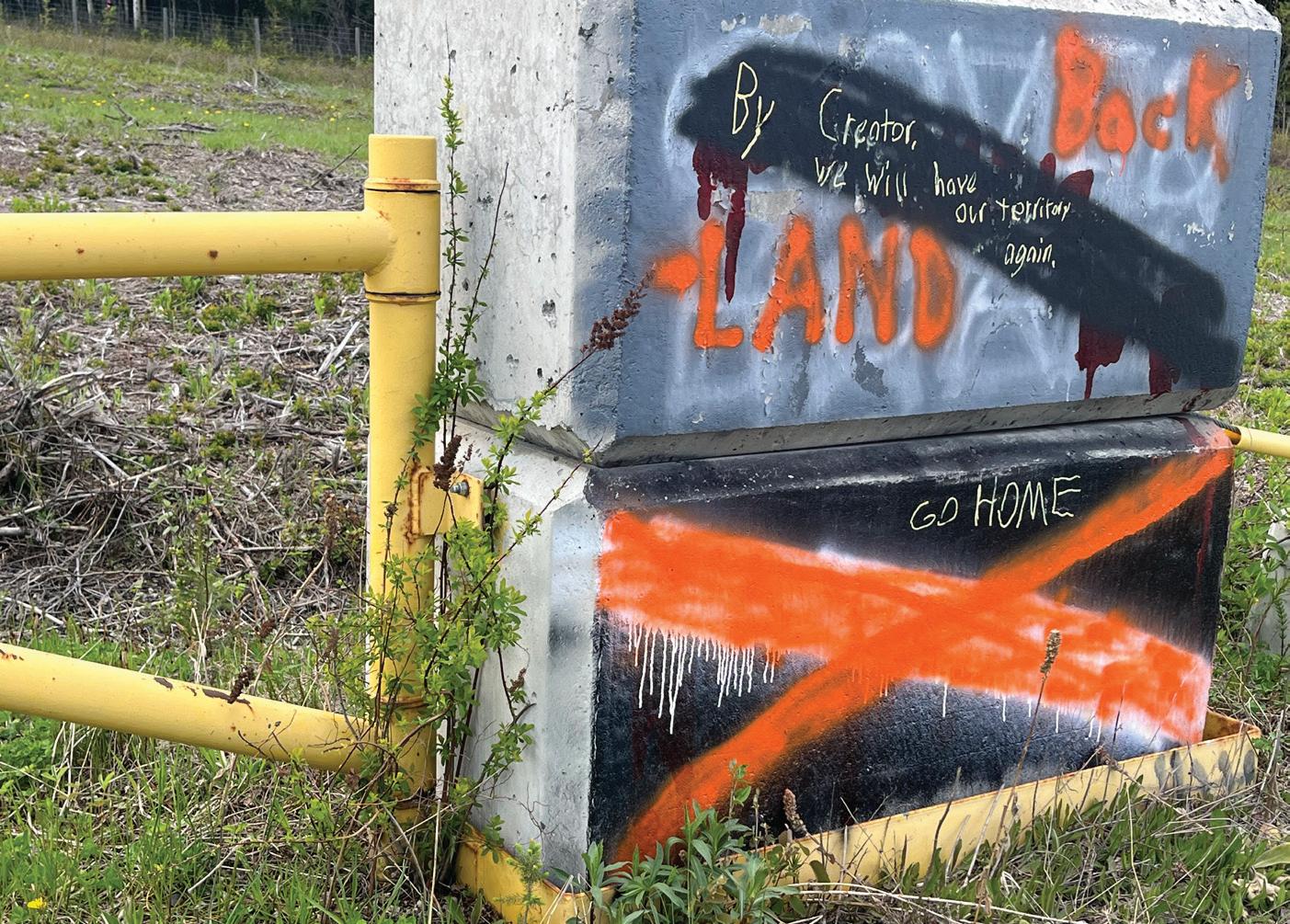

places where teenage boys hang out, trying to sell neo-Nazism and xenophobia under the guise of masculinity and family values. And it goes downhill fast from there.”
The group has noted that a disproportionate amount of the messaging is found near locations frequented by youth.
“We’re seeing it around high schools a lot,” they said. “But from what we’ve seen, it’s not high schoolers. It’s men in their mid-20s to late 40s. We’ve seen some of them putting up flyers and stickers. It’s no longer just some old white guy. It’s people my age too.”
They believe there are only two groups in Prince George responsible for much of the propaganda and that they frequently alter their messaging and symbols to confuse the public.
“I think it’s really only two groups with slightly different values — and they don’t even get along,” they said. “They keep changing the iconography to make it look like there are more people involved. People say, ‘Are you sure that’s a Nazi symbol? I’ve never seen that before.’ But it’s just a dog whistle — to help other Nazis recognize them and build a community.”
While alt-right messaging has been around in small amounts for years, the resident says its presence has grown more steadily in recent times.
“It wasn’t this bad 10 years ago,” they said. “It’s been a slow but steady rise. It’s not like COVID caused it — it’s just more people getting desperate to find a community.”
Despite their group’s small size, they believe anyone in Prince George can help fight back against the spread of white supremacist messaging.
like the right thing to do. I have the time and resources, and I want to make a positive impact on my community.”
The resident has been removing hate-motivated graffiti for more than four years. Over the past year, they’ve formed a small network of others in Northern BC and along the coast who are also taking action in their own communities.
They say the group has observed recurring patterns in the placement of white supremacist graffiti.
“Pretty much every time we go to Prince George, there’s at least one thing,” they said. “It’s not like you take one down and two more go up. It’s more like, we’re figuring out where to look. Certain alleyways, malls, and frequently used spaces. They’re clearly targeting
“I wish more people were involved,” they said. “We’re not trying to start a group that becomes a target. But it’s deflating when people just walk past this stuff. They say, ‘It’s not hurting anyone,’ but it is — it normalizes it. These symbols are scary for a reason.
“My advice is simple: if you have a scraper, scrape it off. Educate people on the symbols. And if you can’t scrape it, cover it up.”
Detours are in place on Queensway between 15th and 17th Avenues until Friday, May 30 while PRD Construction crews work at installing a new water supply line to Hardwood Place Apartments, 1575 Queensway, set to become a BC Housing residence for youth who are currently living in shelters or who are aging out of care.
The project is expected to open this spring after a sprinkler system is added, ventilation upgrades are made and electrical and fire alarms installed.

MATTHEW HILLIER Citizen Staff
Construction began on Tuesday along Tabor Boulevard as the City of Prince George launches a project to replace aging streetlight infrastructure between 15th Avenue and First Avenue.
This project is now part of a multiyear initiative to replace aging and failing streetlights across the city.
The project will replace these lights with brand new energy-efficient LED lights that will be installed in improved locations to enhance nighttime visibility on both streets and sidewalks, increasing the safety of all road users. The construction is anticipated to last through the summer and wrap up in September.
The city also states that of the 4,700 streetlights in Prince George, nearly 1,000 have been identified as needing replacement.

Many of the lights needing replacement were installed in the 70s and are now far beyond their service life and do not meet the current City standards or electrical code requirements.
Work will include the removal, disposal and installation of new poles and modern lighting infrastructure.
In total, 68 new streetlights will be installed on Tabor between 15th Avenue and First Avenue.
The construction budget for the project is approximately $2.5 million.
Residents are reminded to obey posted signage and drive cautiously around construction zones.


Celebrate the special women in your life with Ave Maria Specialtes! We have a wide range of products from treats like chocolate and tea to spa and beauty items such as perfume or bath salts to make any of the women in your life feel appreciated and pampered. With moms doing so much for us everyday its great to show her how much she means to you with something she may not think to get herself.

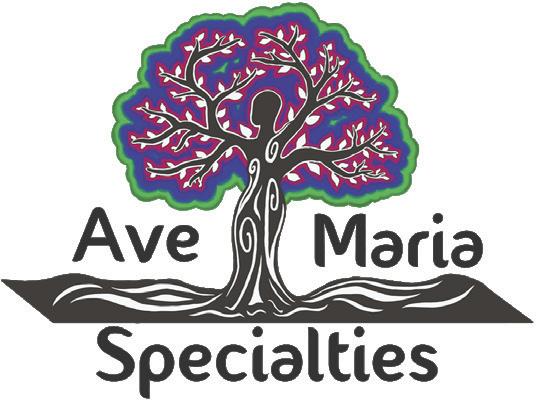

Former Citizen court reporter Mark Nielsen was interviewed for the show, but has no interest in watching it
TED CLARKE Citizen Staff
A documentary about a serial killer who stood trial in Prince George for murdering three local women and a Vanderhoof teen is now available on several streaming platforms.
Making of a Serial Killer: Cody Legebokoff tells the story of one of Canada’s youngest serial killers. Legebokoff was 19 when he killed his first victim, 35-year-old Jill Stuchenko.
He also murdered Cynthia Maas, 35, Natasha Montgomery, 23, and 15-yearold Loren Leslie.
Despite multiple searches, Montgomery’s body was never recovered. However, her DNA was found on a pickaxe discovered in Legebokoff’s residence — the same weapon he used to kill Maas — and was used to convict him of Montgomery’s murder.
Mark Nielsen, who was The Citizen’s court reporter during Legebokoff’s trial in the summer of 2014, is one of several interview subjects featured in the 46-minute documentary.
The program, produced by U.K.-based FirstLook TV, is now available on YouTube, Paramount+, Apple TV+, Prime Video, Tubi and Sky.
Raised in Fort St. James, Legebokoff came from a well-regarded family. His crimes shocked those who knew him as a popular teenager active in sports. Kathleen Leslie, who knew Legebokoff’s grandparents in Fort St. James, said she could never say anything bad about them.
“The hard part is anyone who knew him would never suspect for one minute that anything like this would go on,” Leslie said.
Legebokoff was arrested on Nov. 27, 2010, north of Vanderhoof after an RCMP officer spotted him turning onto Highway 27 from a logging road while driving erratically. A conservation

officer later retraced the truck’s tracks in the snow, leading to the discovery of Loren Leslie’s body.
“I’m not an expert on this stuff, but it’s not the first time a traffic cop has busted open a case,” Nielsen said. “He was driving a purse back to Vanderhoof that a woman had forgotten in Fort St. James when he saw the bouncing lights (of Legebokoff’s truck), and he noticed the erratic driving. He was trying to get away from the scene — and that’s how he got caught.”
The shorts Legebokoff was wearing at the time of his arrest were stained with Montgomery’s blood.
First released Jan. 9, the documentary includes interviews with Loren Leslie’s father, Doug Leslie, and grandmother Kathleen Leslie, as well as Prince George–Cariboo MP Todd Doherty, forensic psychiatrist Dr. Joni Johnstone, and criminologist Everett Parr.
On May 10, a local film technician visited the Citizen newsroom to set up a video link between Nielsen and an interviewer in London, England, to discuss his experience covering the three-month trial.
On Sept. 11, 2014, a jury found Legebokoff guilty of four counts of
first-degree murder. He was sentenced to life in prison with no chance of parole for 25 years. At age 24, he began serving his sentence at Kent Institution, a maximum-security prison, before being transferred to Warkworth Institution, a medium-security facility in Ontario, in January 2019.
The producers of the documentary contacted Citizen managing editor Kennedy Gordon, who forwarded Nielsen’s contact information.
Nielsen was previously interviewed for Court Junkie, a podcast that released an episode in 2017 titled The Case & Trial of One of Canada’s Youngest Serial Killers.
During the Legebokoff trial, Nielsen logged three weeks of overtime. Most days, he spent six hours in court, followed by several hours writing his daily stories. The case produced 95,000 pages of evidence, involved 4,000 contacts by investigators, and featured testimony from 195 police witnesses.
“It was mostly lab techs holding up test tubes — the continuity of evidence,” Nielsen said. “Anybody who had any contact with Legebokoff was willing to get up on the stand and tell their story.”
Nielsen agreed to be interviewed for the documentary because he had gotten to know Doug Leslie during the trial and wanted to help maintain public awareness of Legebokoff’s crimes, and to support the Loren Donn Leslie Foundation, which promotes youth empowerment and encourages students to speak out against bullying.
“I did it as a favour to Doug — he wanted to keep it in the public eye,” Nielsen said.
“It’s a matter of time before Legebokoff goes before the parole board, and I’m certain the public has a lot of influence over whether the board decides to grant release.”
Nielsen interviewed Doug Leslie several times outside the Prince George courthouse during the trial and recalled how deeply affected he was by the loss of his daughter.
“Doug went through a lot, and it was all he could do to keep it together,” Nielsen said. “Now that he’s passed — Doug died of lung cancer on March 15 — I remember he asked the cops, ‘Just give me five minutes with him.’”
Nielsen said he has not watched Making of a Serial Killer and has no desire to see it.
This story includes coverage of court evidence that some readers may nd disturbing
BOB MACKIN
Local Journalism Initiative Reporter
A woman who admitted making and sharing pornography featuring her young child and using a cat in a sex act was sentenced to 7 1/2 years in prison by a Provincial Court judge in Prince George on Thursday, May 15.
“It disturbs us all when we hear such acts of violence perpetrated by a mother against her child,” said Judge David Simpkin.
The woman, whose name is banned from publication in order to protect the young victim, had pleaded guilty in November 2023 to four offences between January 2021 and May 2022: making child pornography, distributing child pornography, sexual interference of a person under 16 years of age and bestiality with a cat.
The Crown had asked Simpkin for a total jail sentence of eight to 10 and a half years.
Defence sought two years, less a day, to be served in the community, including six months house arrest, plus three years probation.
The maximum jail sentence for making and distributing child pornography is 14 years. For bestiality, it is 10 years.
Simpkin said the young victim “should have been safe and protected in the care of her mother. She was not. She was exploited by her mother for what appears to have been her mother’s own sexual gratification and for the sexual gratification of (her husband.)”
Simpkin called it the “most extreme type of breach of trust.” The victim will be traumatized and, at some point, ask why her mother is no longer in her life.
The case started in March 2022 when Facebook reported five suspected images of child pornography to the National Center of Missing and
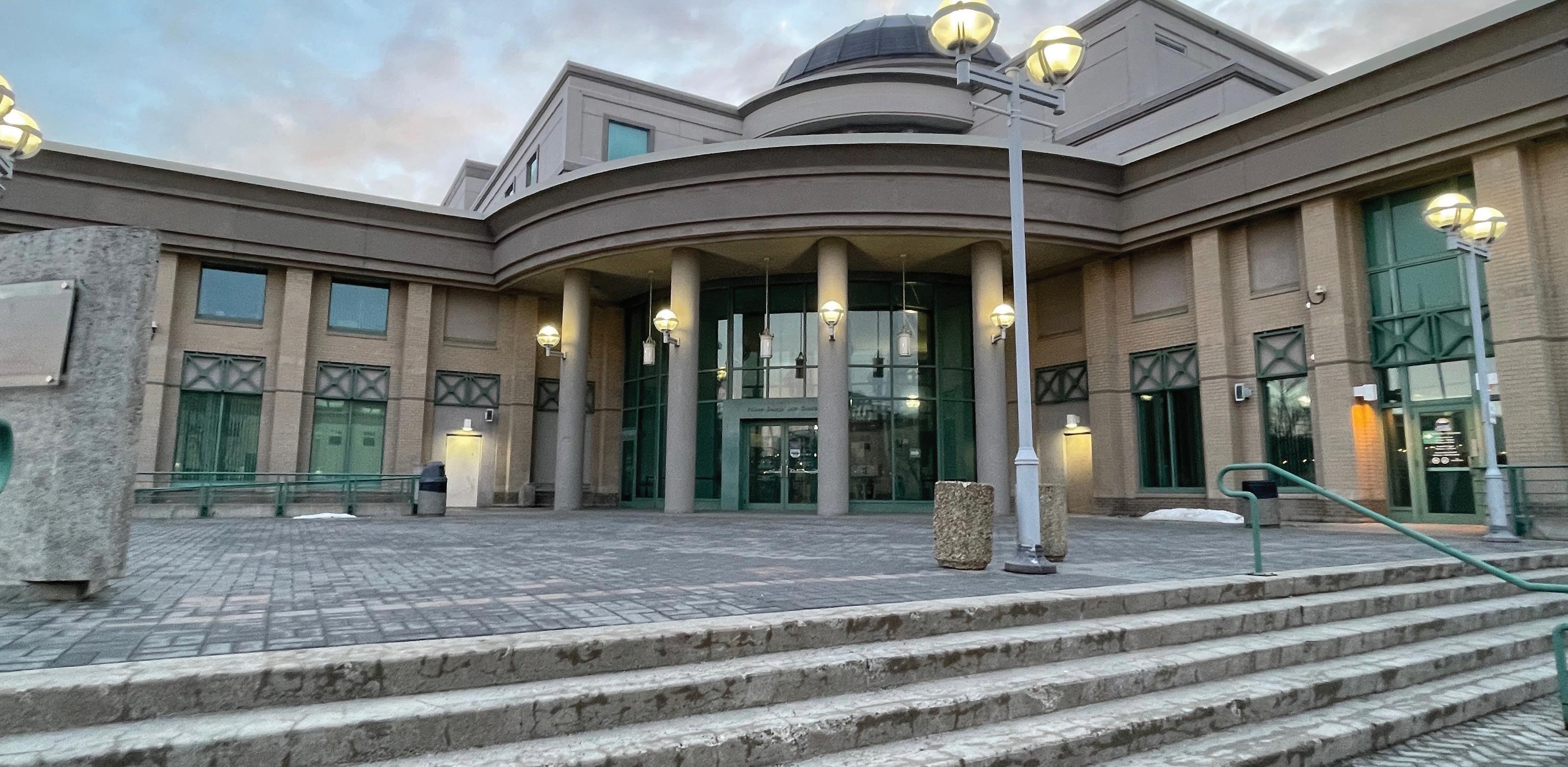
Exploited Children in the U.S.
The images were sent by the woman to her then-husband, who was living somewhere in the U.S.
The Facebook report led to an investigation by Prince George RCMP, which executed search warrants at the woman’s home and examined her electronic devices. RCMP also obtained access to the woman’s Facebook messages under the Mutual Legal Assistance Treaty with the U.S.
Police found numerous still and video images of the woman in sexual positions with the child, who was preschool aged at the time. There were also videos of a cat licking or eating catnip from the woman’s vagina.
The woman shared the images with her husband, engaged in lewd conversations with him and her search history included a long list of phrases, including “family rape,” “forced sex” and “raping little girl.”
Court-ordered pre-sentencing reports said the woman claimed to have been diagnosed as bipolar and suffered from gout, high blood pressure, diabetes and migraines. She said she had been the victim of sexual assault and exploitation.
She told one of the report writers that she had no recollection of creating sexualized content of her daughter nor touching her daughter in a sexual manner, because “she was drinking heavily to the point of blackout.”
She also claimed she acted in fear of her husband, who had access to all of her online accounts.
“(She) was fearful of what he would say or post online, that she could lose her TikTok and OnlyFans accounts from which she was earning money,” Simpkin said.
At a hearing in February, the woman’s lawyer, Keith Jones, told the court that she married the man over the Internet and had never met him in person.
According to a pre-sentencing report, the woman, who had no prior criminal record, was considered a moderate risk for sexual re-offence, and an even greater risk when drinking alcohol or using marijuana.
Simpkin said aggravating factors included her very high moral culpability, the amount of planning involved in the abuse and treating her child as a mere object unable to protect herself.
“The defence position invites me to find that (the woman) was in the thrall
of (her husband) and subject to his direction. This latter position is not supported in materials before me.”
The woman’s Metis heritage and guilty pleas were mitigating factors. Without a trial, valuable court and police resources were saved, thus preventing the woman’s other children from being called to testify.
Simpkin explained that he crafted a sentence aimed at denouncing the woman’s conduct, deterring her from reoffending and deterring others from committing similar offences. But, he said, the task of a judge is “to not lose sight of the prospect of rehabilitation.”
Simpkin imposed several conditions for the woman upon her release.
She will be on the national sex offender registry for 20 years and cannot have control or custody of an animal for 10 years.
She is also prohibited for 10 years under the criminal code from having any contact or communication with a person under age 16, attending any public park or facility where persons under age 16 are likely to be present and must not use the Internet to access pornography or attempt to communicate with a person under 16.
BOB MACKIN Local Journalism Initiative Reporter
A member of the B.C. Human Rights Tribunal ruled that an orthopedic surgeon’s case against a fellow orthopedic surgeon and Northern Health Authority will proceed to a hearing.
In an April 1 ruling, Andrew Robb denied applications to dismiss the complaint from Dr. Anthony Joseph Costa.
Costa and Dr. Michael Moran both practiced at NHA-operated University Hospital of Northern B.C. in Prince George. Costa took leaves due to depression symptoms related to the structuring of on-call responsibilities.
Costa alleged that NHA failed to modify the schedule to accommodate his medical needs and removed some of his hospital privileges, including operating room access.
He eventually resigned in December 2021 from NHA, because of NHA and Moran’s failure to accommodate his disability and NHA’s failure to provide a

discrimination-free workplace.
Costa said in his complaint that he asked Moran in September 2020 to be more supportive of his mental health when Moran told him he planned to return him to the on-call schedule. Moran, Costa claimed, said “you’ve pissed me off” and “why don’t you just
BOB MACKIN Local Journalism Initiative Reporter
A 48-year-old Prince George man was fined $1,500 after he pleaded guilty May 14 to driving while prohibited.
Provincial Court Judge Cassandra Malfair agreed with the joint Crown and defence proposal for Troy Alvin Mruk, who is in custody on a nearly year-long sentence imposed by a Provincial Court judge in Kelowna in March.
Court heard that, on Nov. 13, 2024, Mruk was served with a driving prohibition after an RCMP officer investigated a vehicle idling in Moccasin Flats.
The police database showed that Mruk’s Alberta licence had been surrendered and he was not licensed to drive in B.C.
On Dec. 20, 2024, officers attended the Carmel Inn for a different matter. Mruk and his mother were refusing to leave after their checkout time.
Members of the division voted to remove Costa in March 2021. In April 2021, an independent medical examination found Costa had developed an adjustment disorder “due to work-related issues,” and was fit to practice with no restrictions.
But Costa did not return to the on-call schedule.
“After receiving the report, NHA says it continued to try to find a workable solution for Dr. Costa,” Robb wrote.
“It says it engaged in discussions with him about returning to practice and on-call duties during the following months.”
quit like you said you would?”
“Dr. Moran’s application to dismiss does not address this allegation,” Robb wrote.
A doctor’s letter the next month said Costa had been diagnosed with a major depressive episode and he needed to be removed from the on-call schedule.
Costa unsuccessfully proposed returning to the rotation such that he would never be on-call for more than 24 hours at time or in a shift adjacent to his wife, Dr. Denise Mackey.
Costa originally filed the complaint in July 2021 and amended it in January 2023.
Separately, he alleged in August 2022 that he was subject to retaliation for filing the original complaint.
driving while prohibited

Moccasin Flats is seen in a photo taken in November 2024. It was around this time that police checked a vehicle idling in the encampment and found a man behind the wheel who was prohibited from driving.
Mary Mruk told police that her son would return shortly after driving.
When he showed up, Mruk was arrested for driving while prohibited.
The Mruks had been staying at the motel after being evicted from their residence and both had health conditions.
Troy Mruk had left the motel briefly to pick up a prescription at a pharmacy.
“Their normal routine was a little bit
out of whack,” defence lawyer Jason LeBlond told Malfair.
“So he certainly knew he was prohibited. Certainly there’s a risk to other drivers. He’s not insured. If there had been an accident, there would have been significant consequence for both Mr. Mruk and anybody involved.”
LeBlond said Mruk has made contact with ICBC and is “working on trying to
get his licence back.”
Malfair decided the fine did not contravene the public interest and would not bring the administration of justice into disrepute.
She gave Mruk until May 13, 2026 to pay the fine.
Mruk is also prohibited from operating a motor vehicle or conveyance on any public or industrial road for a year.
Provincial Court Judge Andrew Tam sentenced Mruk in March to 358 days in jail for intimidating a justice system participant.
The total sentence was 15 months, but Mruk qualified for 92 days credit due to pre-sentence custody.
Tam said he would have been sentenced sooner had it not been for lying to the court about his mother being hospitalized after a heart attack.
LeBlond told Malfair that his client is considering an appeal and application for parole.
CITIZEN STAFF
Prince George RCMP are investigating the shooting of a 15-year-old girl in a parked trailer at Moccasin Flats in the early hours of Wednesday, May 14.
A media release sent out just before 10 a.m. that day said the girl sustained serious but non-life-threatening injuries.
“The investigation is still in its preliminary stages, but there is currently no indication there is any increased risk to the general public resulting from this incident,” said RCMP media relations officer Cpl. Jennifer Cooper.
The Serious Crimes Unit is handling the investigation.
One officer visited neighbouring businesses Wednesday morning to inquire about security footage. Investigators arrived at the crime scene in the early afternoon and began collecting evidence. Later in the day, officers could be seen marking what appeared to be
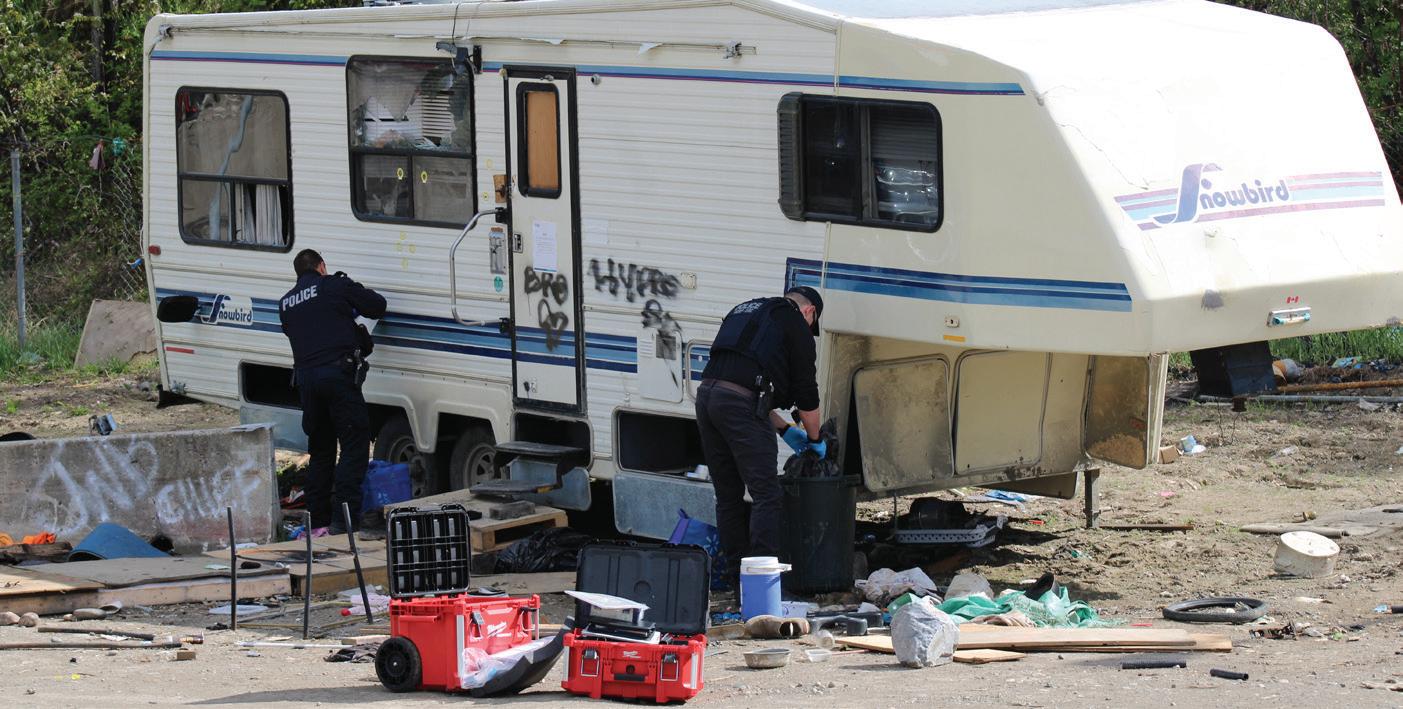
investigate at
Flats in Prince George on Wednesday, May 14.
bullet holes on the trailer.
“We are asking that anyone who may have video surveillance or dash camera footage, or any information regarding this incident, please call our non-emergency number to speak with an investigator,” Cooper stated.
A Moccasin Flats resident told The
MATTHEW HILLIER Citizen Staff
The BC Coroners Service has released new data on unregulated drug toxicity, revealing continued high death rates in several regions of the province.
According to the latest report, the highest rates of drug toxicity deaths were recorded in the Interior and Northern Health regions, each with a rate of 35 deaths per 100,000 people.
Northern Health reported five unregulated drug deaths in February and 12 in March. Of those, nine occurred in the Prince George area.
Preliminary provincial data show that 132 people died in February and 143 in March 2025 due to unregulated drug toxicity. This equates to an average of 4.6 to 4.7 deaths per day in B.C.
By local health area, the highest death rates were reported in Vancouver -Centre North, Lillooet, Greater Campbell
River, Terrace and Prince George.
The cities with the highest number of unregulated drug deaths in 2025 to date are Vancouver (97), Surrey (52) and Greater Victoria (28).
In 2025, fentanyl was detected in 70 per cent of unregulated drug deaths, followed by methamphetamine (50 per cent), fluoro-fentanyl (47 per cent), cocaine (46 per cent), bromazolam (37 per cent), desalkylgidazepam (34 per cent), and hydromorphone (3 per cent).
The majority of drug consumption occurred by smoking (62 per cent), followed by nasal insufflation (11 per cent), injection (11 per cent), and oral ingestion (five per cent).
About 75 per cent of reported deaths occurred indoors. Of those, 45 per cent were in private residences and 43 per cent in other types of housing, including social and supportive housing.
Only 20 per cent of deaths occurred outdoors.
Moccasin Flats for several weeks, was taped off Wednesday as police carried out their investigation.
A police cruiser remained parked on one side of the yellow tape while an unmarked vehicle brought officers to the scene just before 9 a.m.
Police also taped off a vacant lot on the north side of Fourth Avenue at London Street, where a seacan had been used as a shelter.
Earlier in May, the city installed locking gates at either end of the encampment.
Citizen that he heard shots at about 3 a.m. Police stated the incident happened shortly after 1 a.m.
After being interviewed by RCMP, all residents of the camp were ordered to leave the area at about 3:30 a.m.
The area surrounding the fifth-wheel trailer, which has been parked at
At least one person has been living in the trailer, which is located near the western edge of the Lower Patricia Boulevard encampment, since late winter. About a dozen people are still living there, after efforts were made to establish temporary housing in Atco trailers on Third Avenue and in other locations around the city.
With files from Colin Slark and Ted Clarke





‘I have no hesitation in saying that Mr. Dunk is an absolute menace to society’
BOB MACKIN
Local Journalism Initiative Reporter
A 38-year-old Prince George man pleaded guilty May 12 to stealing all-terrain vehicles from the Canfor Mill in Mackenzie more than two years ago.
In Prince George Provincial Court, Associate Chief Judge Paul Dohm heard that a mill employee called RCMP after the incident on April 25, 2023.
Surveillance footage showed a man smoking a cigarette.
The butt was recovered from the scene, tested and matched Christopher Ross Dunk’s DNA.
An officer found two ATVs four days later at Dusty Trail Riders in Prince George after a report that someone was cutting the locks off gates.
Dunk was sentenced to time served for that offence, but received a year in jail and six months of living under 9 p.m. to 6 a.m. curfew after pleading guilty during the same session to two counts of possessing stolen property over $5,000.
An officer investigating multiple thefts on Highway 16 near Westgate Avenue at 3 a.m. on July 23, 2023, noticed a black

Dodge pickup truck towing a white cargo trailer speeding eastbound.
The vehicle turned into the Treasure Cove Casino parking lot, then sped away.
An RCMP drone was eventually deployed to find the truck and trailer.
An officer saw an ATV drive away from him in an industrial area and a police dog was needed to find Dunk, who sustained bites on both legs and a bloodied
face in the takedown.
Crown prosecutor Astitwa Thapa proposed a total penalty of 791 days in jail and 180 days in the community, under curfew.
Dunk received 426 days credit for time served in pre-sentence custody.
Court heard that Dunk had no trouble with the law since 2008, after compiling a record of three theft and two possession of stolen property convictions. He
also breached probation seven times.
“I have no hesitation in saying that Mr. Dunk is an absolute menace to society, his conduct is unacceptable, and I hope he uses his time in custody to fully appreciate the consequences of his actions,” Thapa said.
Thapa said there were several mitigating factors, primarily Dunk’s guilty pleas.
Had Dunk been tried on all eight charge sheets, 25 days of court time would have been required.
Numerous out-of-town and out-ofprovince witnesses would have been called.
Dunk’s lawyer, Tony Lagemaat, said that his client owns a home in Prince George and has been employed. He fell in with the wrong crowd after a “challenging breakup” with his girlfriend and returned to abusing drugs.
Dunk addressed the judge and took responsibility for his offences.
“There’s no excuse for them, nor is there any adequate apology I give to the courts or people affected in the community,” Dunk said.
Thapa acknowledged Dunk’s family and friends in the gallery and their letters of support.
He said Dunk’s words of remorse were what they “want to hear.”
“They love you, they respect you, they want you to be the person you can be,” Thapa said.
BOB MACKIN
Local Journalism Initiative Reporter
A BC Supreme Court judge dismissed a Houston industrial railway’s attempt to expropriate a statutory right of way from a neighbouring logging company and pay $34,000 compensation.
In a May 2 verdict, Justice Michael Stephens said that he would have assessed $363,697 in compensation had West Point Rail and Timber Co. been entitled to expropriate land from Tahtsa Timber Ltd. under the Railway Act.
West Point had offered almost a quarter of that amount before seeking the court’s intervention.
At issue was the 2,300-foot rail line over three acres of Tahtsa’s 66-acre parcel and how much West Point, whose rail line totals 21,780 feet, should compensate Tahtsa.
Tahtsa acquired the land in 2013 and claimed to own the 1983-built railway siding that runs over its land. West Point bought the property south of Tahtsa in 2018.
In February 2019, Coastal GasLink made an agreement with Tahtsa and
registered a temporary statutory right of way for 30 months until the end of August 2021 for use in its pipeline project.
CGL paid to upgrade the rail line and made a separate temporary site lease with West Point in August 2020.
After the CGL agreement expired, Tahtsa and West Point began talks about West Point’s lack of statutory right of way.
West Point continued to use the rail line until Tahtsa’s 2022 blockade.
After it ended, West Point served Tahtsa notice in November 2022 to
expropriate a 3.06 acre statutory right of way. Tahtsa rejected the $92,441 compensation offer.
Stephens heard a trial over four days last November and ruled West Point does not have the power to expropriate Tahtsa land under the Railway Act.
“I do not make any findings as to whether West Point has been, or is currently engaged in, actionable trespass on the Tahtsa land,” Stephens wrote. “There is no claim or counterclaim filed by Tahtsa for trespass before me at trial.”
ABIGAIL POPPLE Local Journalism Initiative Reporter
Mountain goats have had a continuous presence in North America since they plodded across the Bering Strait tens of thousands of years ago, and the fluffy white creatures are ubiquitous on signs and statues throughout the Robson Valley.
Despite their endearing place in local iconography, the valley’s mountain goat population has been declining over the past few decades — and researchers are unsure why.
However, new research under way in the Robson Valley may give clues as to why populations are declining. Led by Kara MacAulay, a Prince George-based wildlife biologist for the Ministry of Water, Land and Resource Stewardship, the study will track 30 female mountain goats using GPS collars.
This is the fourth study on Robson Valley mountain goat populations, which have recorded an alarming decline in the number of goats since the first study in 1998, said MacAulay.
“There’s about a 70 per cent decline in numbers from the 1998 survey to the most recent one (in 2021),” MacAulay said. “Other biologists are also noticing similar declines… it’s really an unknown cause of decline. The same goes for the population in the Robson Valley – we don’t really know what the decline is caused by.”
One early theory was that overhunting could be impacting the population, but the evidence has not shown that hunting is the cause, according to MacAulay.
The mountain goat harvest has been kept under the recommended three per cent of the population per year, with very few females harvested, she said. Additionally, areas which do not allow hunting — such as Mount Robson Provincial Park and Alberta’s Castle Provincial Park — have seen similar declines in their mountain goat populations, MacAulay said.
Other working theories for the decline include habitat changes or a lack of food making it harder for goats to survive

and raise offspring, but it’s difficult to speculate on the cause, according to MacAulay.
So far, researchers have deployed 20 collars on local mountain goats, and they will add the remaining 10 collars next winter.
The collars allow researchers to track the survival of goats by sending an alert when a goat has not moved for several hours. Researchers will then travel to the site where the goat was last recorded and determine its cause of death, whether it was health-related, predation-related, or a natural death caused by an event such as an avalanche.
Researchers will also do one to two recruitment surveys a year, meaning they will use a helicopter to find collared goats and see if they have offspring with them. MacAulay said this will help researchers determine if high juvenile mortality rates are behind the population decline.
Conservation is the main goal of the study, MacAulay said. Aside from the socioeconomic reasons for preserving mountain goat populations – people travel from across the world to hunt goats in B.C. every year, according to MacAulay – they have cultural
significance to First Nations and B.C. residents in general, she added. Once researchers identify the cause – or causes – of decline, they can work with local governments and the Ministry of Water, Land and Resource Stewardship to implement policy changes that may help sustain mountain goat populations throughout the province.
“We don’t want to see declines in these populations, especially when we don’t know the cause,” MacAulay said. “If we can figure out the cause, maybe we can either stop or reverse that decline.”
The research is funded through a grant from the Habitat Conservation Trust Foundation, a Victoria-based nonprofit which funds habitat restoration and studies on fish and wildlife.
The foundation recently granted a total of $8.6M to 110 projects throughout BC, said CEO Dan Buffett.
“The goal is to improve outcomes for fish, wildlife and [their] habitats,” Buffett said. “We know they’ve experienced lots of decline in many of those populations over the years. It’s trying to return those populations and also to protect, restore and enhance habitat for those fish and wildlife species.”
The mountain goat study is just the
latest in a slew of projects the organization has funded in northern B.C., Buffett added.
According to him, the Foundation also funded a project to remove unused roads in Sugarbowl-Grizzly Den Provincial Park in 2023 because they disrupted animal movement, and in the same year the organization worked with First Nations to improve caribou habitat near Kinbasket Lake.
The foundation is funded through provincially-mandated fees for hunting and fishing licences, and supporters can donate online at hctf.ca. Occasionally, the Foundation funds projects that locals can get involved in, such as the annual BC bat counting project, where residents count bats at roost sites near where they live.
However, Buffett says one of the best things nature-lovers can do is spend time outdoors.
“Get out into nature — it’s good for our physical and mental health, and helps us appreciate the value that wetlands and forests and grasslands have for us,” he said. “You recognize that nature needs space, so it’s important to protect it.”
This story originally appeared in The Rocky Mountain Goat.
Barkerville Historic Town & Park has its Shoulder Season until May 30 with select shops and exhibits open with admission by donation. Then the main season goes from Saturday, May 31 to Saturday, Sept. 6. For more information visit www.barkerville.ca/ main-season/#mainseason.
Cinematography One-Day Workshop goes Friday, May 23 or Saturday, May 24, Friday, June 27 or Saturday, June 28 from 9 a.m. to 5 p.m. and is presented by the Arts North Digital Media Centre, a division of the Community Arts Council of Prince George & District at Studio 2880. The workshop is led by Jeff Gruending, local founder of video marketing firm Precision FX,and includes camera fundamentals, lighting essentials, audio production, composition & storytelling, editing & final production. For more information and to register visit www.studio2880. com/arts-north-digital-studio-media/ cinematography-workshop.
Aged to Perfection: Scotch for a Cause goes Saturday, May 24 from 7 to 10 p.m. at The Exploration Place, 333 Becott Place. This curated tasting experience is a fundraiser filled with luxury, flavour, and philanthropy. Savour world-class scotch and chef-curated pairings, all while supporting The Exploration Place’s commitment to education and innovation. For more information and tickets visit https://theexplorationplace.com/aged-to-perfection/.
Navy League of Canada-Prince George branch Bottle Drive Fundraiser goes Saturday, May 24 from 10 a.m. to 4 p.m. the Connaught Youth Centre parking lot in the back at 1491 17th Ave. On Saturday, May 31 at the Salmon Valley Volunteer Fire Department, 5155 Salmon Valley Road. Funds raised will get camp levers up and running for 158 Grizzly Sea Cadets and 142 Aurora.
Jessica McMann Trio goes Saturday, May 24 at 7:30 p.m at Knox Performance Centre, 1448 Fifth Ave. McMann is an Alberta -based Cree (Cowessess, SK), multi-disciplinary artist who interweaves land, Indigenous identity, history, and language throughout her dance and

music creation/performance practice.
A classically trained flutist, she holds a Bachelor of Music degree from the University of Calgary and an MFA in Contemporary Arts from Simon Fraser University. Her work fuses together traditional language and dance with her own contemporary experiences as an Indigenous woman and Two-Spirit person. For more information and tickets visit www. knoxcentre.ca/upcoming-shows.
Walk for Alzheimer’s goes Sunday, May 25 at 1 p.m. at the YMCA of Northern BC. Join the walk for people affected by dementia so they don’t have to walk the journey alone. Funds raised at the Walk help the Alzheimer Society
throw, taped-hand throw. Change your perspective, break barriers and have fun. For more information visit www.discgolfscene.com/tournaments/ Playing_in_My_Shoes.
BC Assembly of First Nations Low Carbon Transportation Forum goes Tuesday, May 27 at 9 a.m. at the Prince George Civic Centre. For more information and to register visit www.events.bcafn.ca/ fn-low-carbon-transportation-forum/ registration.
Europa Super Circus goes Thursday, May 29 to Sunday, June 1 at CN Centre for evening and matinee shows. This show features world class artists from all over the globe like International tightwire acrobat, Geoffrey Berhault, Jose Ponce Ramos on the Wheel of Death and the ALL-STAR FMX Ultimate Circus riders. Witness high flying aerialists, dizzying roller skaters and comedic clowns all presented by Europe’s best circus artists. For Prince George tickets visit www.//tickets.supercircus.com/shows/ princegeorge.
of BC deliver programs and services for families on the dementia journey and enable critical research to change the future of the disease. Register as an individual, start a new team, or join an existing team. For more information or to register visit www.support.alzheimer. ca/princegeorgewalk.
Playing in my Shoes Disc Golf goes Sunday, May 25, the first day of Accessibility Week in Canada goes from 11 a.m. to 2 p.m. at Rainbow Park in Prince George, Pilots Grove in Quesnel and Omineca Golf and Country Club in Vanderhoof. Find out how it is to do a wheelchair throw, wrong arm throw, blindfold throw, earplug
Mixology Evening at the Farm goes Friday, May 30 from 7 to 9:30 p.m. at Wildflower Farm, 9295 Pooley Road. Led by Worth A Shot Mobile Bar guests create three summer-inspired cocktails using farm florals and herbs. Master mixologist provides instructions. Get a bouquet of 10 assorted tulips to take home, do a walk thru of the gardens, visit the animals and enjoy the country vibe. $50 per person to register. Text Lisa to join at 250 961 3519 or email wildflowerfarmpg@hotmail.com.
Prince George Gun and Sportsman Show goes Friday, May 30 from 4 to 9 p.m., Saturday, May 31 from 9 a.m. to 6 p.m. and Sunday, June 1 from 9 a.m. to 3 p.m. at Kin 1 & 2. This event features a variety of firearms and outdoor fun. Vendors coming from across Western Canada to bring a selection of firearms, knives, hunting supplies, fishing supplies, ATVs, boats and all things outdoors. Day entrance is $10 and weekend passes are $15.
CONTINUED ON NEXT PAGE
Galaxy Psychic & Crystal Fair goes Friday, May 30 from 2 to 10 p.m., Saturday, May 31 from 11 a.m. to 10 p.m. and Sunday, June 1 from 11 a.m. to 6 p.m. at the Ramada, 444 George St. Some of Canada’s top psychics, mediums, astrologers, rune reading, healers, tea leaf, palm readers will be on hand. Aura photo booth is $20. Lots of beautiful crystals and hand made jewelry. Tickets are $10 and good all weekend. Children 12 and under free. For more information visit www.galaxypsychicfairs.com/princegeorge.
Community Moves Mainstage goes Friday, May 30 at 7 p.m. at the PG Playhouse is presented by Method Dance Society. An unforgettable evening where live music, dance, and film collide. Featuring Danny Bell & His Disappointments in a junkyard disco choreographed by Shelby Richardson. Ecstatic movement & rhythm with Alyssa Favero’s Wanderers, a nature-soaked duet by Ana Sosa & Matt Emmings, a dreamlike film and dance fusion by Shayla Dyble & Matt Leslie and surprises, sound loops, bamboo flutes & psych-folk magic. Come tumble into the weird, the wild, and moving. For more information and tickets visit www. method-dance-society.tickit.ca/events.
Geekshow! goes Saturday, May 31 at 8 to 11 p.m. at Omineca Arts Centre, 369 Victoria St. Improv Shmimprov presents an evening of ultimate Geekery, presenting live theatre, on stage, based on the audience suggestions. Bring the suggestions, we supply the funny. Improv comedy, live on stage with games and tomfoolery. As always, there are snacks and drinky drinks. Doors open at 7 p.m. For more information and tickets visit www.shmimprovimprov.ca/event/ geekshow.
Wrangler Round Up 4-H Dinner & Dance goes Saturday, May 31 at 6 p.m. at Pineview Hall, 6479 Bendixon Road. Support the Prince George 4-H district at the annual fundraiser. Wear your western best for best dressed contest. There are spot dances and a silent

auction starting at 6 p.m. There is a dance with a DJ that will follow dinner. Tickets are $50 each, cash bar only. For more information contact Liz Ramsay at 250-301-4686 or email pineview.4H. club@gmail.com.
90s Icon Extravaganza goes Saturday, May 31 at 6 p.m. at Crush Nightclub, 1192 Fifth Ave. Join Wilma Knickersfit and Lola O’Dare as they celebrate their birthdays in true 80s baby style with an iconic night of 90s inspired burlesque, drag and comedy. Fun, fierce and fabulous live performances, raffle prizes, a costume contest and a dance off, featuring a 90s style after party with DJ ANT. Tickets available at Omineca Arts Centre, 369 Victoria St. Open hours Tuesdays to Fridays from noon to 5 p.m. $25 presale tickets for general seating first come, first seated. Cash only or etransfer accepted. Name and email required upon purchase.
Northern BC Multicultural Children’s Festival goes Saturday, May 31 at Lheidli T’enneh Memorial Park. Free entertainment, engaging games, and tasty food options (some costs may apply). There’s something for everyone. Let’s kick off this annual tradition with smiles, laughter, and lasting memories
In The Wind — Happy Birthday, Marilyn! on Sunday, June 1 at 7 p.m. at OM Pizza Bar Café, 1970 Ospika Blvd. S. An unforgettable night of live music and legendary performances pay tribute to the Queen of the Golden Age of Hollywood on her 99th birthday. Party games, prizes, live music and more. For more information and tickets visit www. eventbrite.ca/legendslive.
WalkPG 2025: Wild about Lheidli Keyoh Prince George Outdoor Festival goes Saturday, May 31 from 9:45 a.m. to 3:15 p.m. at Cottonwood Island Park, River Road. This is a free family-friendly event to celebrate adventure, culture and the beauty of nature. There will be a variety of hands-on workshops and activities for all ages. This event is presented by Wild About Outdoors Learning Society.
to cherish for years to come. Come together and join the fun.
Chamber Music Concert Series Favourites & Friends with special guest Method Dance goes Sunday, June 1 at 3 p.m. at Trinity United Church, 3555 Fifth Ave. and is presented by the Prince George Conservatory of Music. The program blends classical favourites by Bach and Tchaikovsky with traditional tunes and brand-new compositions. The concert includes musicians playing violin, viola, voice, saxophone, piano, accordion, harp, bass clarinet, flute. This one-of-a-kind performance promises to be a rich and joyful celebration of the arts. Admission is pay-what-youmay at the door.
Carwash and Barbecue goes Sunday, June 1 from 11 a.m. to 3 p.m. at CSN Norgate, 615 First Avenue, is a fundraise for Prince George Palliative Care Society. Get your car washed, enjoy a delicious barbecued hot dog, and have some fun — all while supporting a great cause. Minimum donation of just $5 gets you a hand carwash and a barbecue lunch. Every dollar raised goes directly to the Prince George Hospice Palliative Care Society.
Legends, Live! Presents 99 Candles
Everything Equine Night Market goes Wednesday, June 4 from 5 to 9 p.m. at CN Centre. Got tack collecting dust or looking to score a deal? Don’t miss this ‘Junk in the Trunk’ style tack sale — a fun, casual way to buy, sell, or trade used tack and horse gear right from your truck, trailer or table. Plus, shop from amazing local equine businesses offering everything from equine inspired decor, clothing lines, boutiques, vets, supplement suppliers, equine care and more! We will be looking for a food truck or two as well! Spots will be $15 each and are filling fast, bring your horse trailer and set up a booth, bring a tent, or whatever suits you. Please contact Alicia Vogl to reserve your spot, or with questions or inquiries at https://www.facebook.com/ alicia.gohl
BC Old Time Fiddlers’ Jams and Lessons go every Tuesday from 7 to 9 p.m. at the First Baptist Church, 483 Gillett St. Everyone is welcome to attend. Drop-in fee is $5 at the door.
If you’ve got an event coming up email us at news@pgcitizen.ca to offer details including name of the event, the date, time and location, ticket price and where to get them and a little bit about what’s happening, too. LOCF
The annual Vaisakhi Nagar Kirtan returned to Prince George on Saturday, drawing community members together in a celebration of Sikh faith and culture. The event began with a parade procession from Guru Nanak Darbar at 10 a.m. and made its way to the CN Centre parking lot by noon. There, attendees were offered free vegetarian meals and snacks, and took in speeches and traditional Sikh martial arts demonstrations. Nagar Kirtan, which means “singing hymns through the town,” is a Sikh tradition in which sacred music and teachings are shared publicly to mark Vaisakhi — the festival that commemorates the founding of the Khalsa, the Sikh community, in 1699.




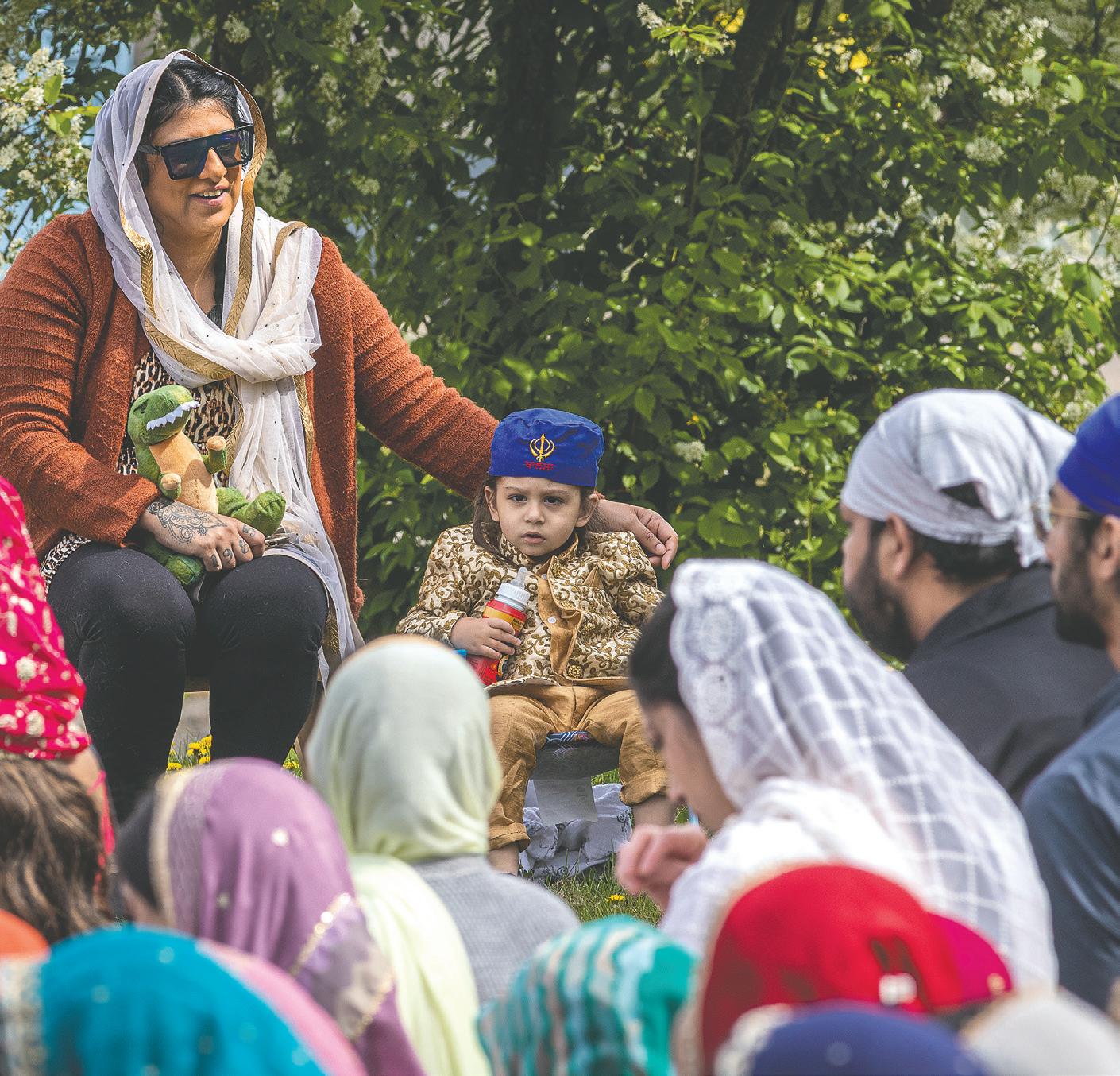
MATTHEW HILLIER Citizen Staff
With North America still reeling from the effects of an ongoing trade war — and with more politicians, businesses and individuals encouraging people to buy local — one UNBC professor has found a new way to inject money into the local economy.
David Connell, a professor at the University of Northern British Columbia, has won a UNBC Award of Excellence in Research in 2017 and a UNBC Award of Excellence in Teaching in 2014. His primary research interests include agricultural planning and local food systems.
Connell recently conducted extensive research into more than 70 farmers’ markets across the province. He concluded that more can be done to bolster farmers’ markets and, by extension, the local economy.
Connell said that simply increasing the amount an average person spends annually at farmers’ markets — from 0.5 per cent to 1 per cent of their food budget — could have a significant impact on both the local and provincial economies.
One person familiar with the potential effects of this 0.5 per cent increase is Martin Krell, president of the Prince George Farmers’ Market.
“It would have a huge impact,” said Krell. “That extra half per cent would allow a farmer — or multiple farmers — to build root cellars to store vegetables for sale in December, January and February. It would allow individuals to expand their animal herds and their offerings.
“It’s better for everyone. When a farmer is making money, they’re willing to try a new crop, expand their greenhouse, or invest in different farming practices. Of course, farming isn’t cheap. A lot of these farmers have their entire life savings tied up in their farms. Raising capital to expand is difficult, and any extra cash flow through the farmers’ market helps. That would increase food stability.”
At the provincial level, Connell

assessed the impact of farmers’ markets operating under the B.C. Association of Farmers’ Markets (BCAFM). His study found that the annual economic impact of farmers’ markets is $232.9 million, with 4.95 million visits and 3.7 million shoppers annually. Direct annual sales at BCAFM member markets amounted to $155.3 million.
Despite the impressive numbers, Connell noted that spending at farmers’ markets still represents only a small portion of an average family’s food budget.
“It represents such a small amount — potentially 0.5 per cent of a household budget,” said Connell. “It doesn’t take much to make an incredibly important contribution to the local food system. Diverting a small portion of your grocery budget to the farmers’ market can have a dramatic effect on strengthening and directly supporting local farmers and the local food system.
“I think people are starting to realize the power of their dollar — and their ability to support something tangible, local and personal. It’s a powerful thing.”
Although $155 million in annual provincial sales is a strong figure, Connell views it more as a demonstration of untapped potential than as an indicator of peak success.
“$155 million seems like a lot at first glance,” he said. “It’s worth celebrating, but when you look at it in the context of what households in B.C. spend on food at grocery stores, it’s only a tiny amount. The results show the potential
to enhance both local communities and the food system.”
More locally, Connell’s study found that farmers’ markets inject $1.63 million annually into the Prince George economy. Direct sales make up $1.09 million of that total, with the average shopper spending $44.50 per visit.
Approximately 24,400 shoppers visit Prince George markets each year.
Surprisingly, only five per cent of shoppers self-identified as tourists or day-trippers, meaning the overwhelming majority are local residents.
Connell told The Citizen that his main goal in conducting the study was to demonstrate and evaluate the economic power of farmers’ markets.
“The main purpose of the study is to demonstrate the value of farmers’ markets,” said Connell.
“That includes their value to local and provincial governments and others who might be interested. Many people know about farmers’ markets, but they don’t always understand their economic and social contributions. Especially among politicians — they like numbers. They like data that tells a compelling story.”
Connell’s research indicates that surrounding businesses also benefit from the presence of a farmers’ market.
In Prince George, 75 per cent of shoppers reported spending an average of $45.02 at nearby businesses after visiting the market. In total, that translated to $1.16 million spent at neighbouring businesses in 2023.
Krell has witnessed the positive spillover effects first-hand.
“We bring, on average, 2,500 people into the downtown core each week,” said Krell. “Those people are wandering the street, grabbing coffee, having lunch, doing some shopping — and then coming back to the market. People are spending two or three hours downtown, and that benefits everybody.”
Beyond economic impacts, Connell also highlighted the social value of farmers’ markets.
“There’s an important social component to markets, and the results speak to that,” said Connell. “Shopping at a farmers’ market isn’t like going to a grocery store, where you get in and out quickly. At a market, almost half of attendees spend at least 30 minutes there — and half of that time is spent socializing. I really like that aspect of it.”
Krell echoed that sentiment, encouraging those who want to support local businesses to head to the farmers’ market.
“There’s a lot of talk about food security and buying local,” said Krell. “The Prince George Farmers’ Market is where the rubber meets the road. It’s where people can buy local. It’s where they can support food security. We don’t need more committees or policies — we just need people to come down, meet their farmers and buy from them.”
Connell is scheduled to present his findings at the upcoming Congress of the Humanities and Social Sciences — one of Canada’s leading academic gatherings.
The event takes place in Toronto from May 30 to June 6.
MATTHEW HILLIER Citizen Staff
Members of the Dutch community recounted stories of Gestapo visits, hiding Jews in their homes and other wartime experiences as the Dutch Canadian Tulip Commemoration was held Saturday, May 17 at Veterans Plaza to mark the 80th anniversary of the liberation of the Netherlands from Nazi forces.
Speakers included members of Legion branch 43, Dutch survivors and children of those who lived through the occupation, all of whom shared their stories with the local community.
One notable account came from Jos Van Hage, owner and operator of Art Knapp’s and a prominent member of the Prince George Dutch community. Van Hage told the crowd a story about his father, who endured the occupation and helped feed their starving community.
“1944 was one of the worst winters Holland ever had,” said Van Hage. “They would walk 30 miles from Amsterdam just to come back with one sugar beet. My dad couldn’t give it to them because the Germans also had sugar beets that came off the boats. The Germans liked my dad because he had steel and made moonshine. Believe it or not, the Germans loved the moonshine. At night, they would get drunk and sleep in the barn. Then my dad would shave the beets to get a handful of shavings and give them to the people from Amsterdam, who walked back 30 kilometres with just that handful of sugar beet shavings.”
The ceremony also paid tribute to the gift of 100,000 tulip bulbs sent to Canada by the Dutch royal family after the war as a thank-you for sheltering them. An additional 10,000 bulbs have been sent each year since as a symbol of remembrance for the bravery and sacrifice of

Canadian troops.
Another story came from Legion 43 president Eric Callaghan, who visited the Netherlands in 2019 and was deeply moved by the respect shown for Canadians and their sacrifices.
“At the end of the day, the Canadians have always been there to help,” said Callaghan. “The Netherlands was one of those places. In 2019, we were at a ceremony in Holland and the construction — everything — stopped when they heard the Canadian anthem. That ceremony went on for 20 minutes. Factory workers, everybody, came to the cemetery, which had about 300 Commonwealth graves. The majority were Canadians. So when you leave Canada, you don’t realize how much people really respect this country. It’s humbling to be there.”
The event follows the recent announcement of May 5 being declared Dutch Liberation Day in Prince George.
Former MLA and member of the local
Dutch community Shirley Bond helped organize the event and told The Citizen that it drew one of the largest turnouts she has seen.
“We are so excited today because this is probably one of the best crowds we’ve had,” said Bond. “It’s a rainy Saturday on a long weekend in Prince George, and I think it gives us hope that there’s a heart to remember.
That’s why we continue this process. We’ve had great partners, and we’re grateful for the media, the city and others who have told our story. We’re just thankful to see so many people come out, stop and take a moment on a busy long weekend to remember and be grateful.”
Bond said she was especially moved by the stories shared and hopes they won’t be forgotten.
“What’s most important to the Dutch community is that there’s an ongoing opportunity to remember, reflect and say thank you,” she said. “Today we
heard stories — ones we hear again and again — about how moved people were by the Canadian soldiers. They brought food and, most importantly, freedom. I think what the Dutch community really wants is to say thank you and to encourage people to keep sharing the stories, so that memory isn’t forgotten.”
Bond also told The Citizen that there are ongoing discussions with the city to make the tulips outside Veterans Plaza a permanent part of Prince George’s gardening program.
She added that locals can support the celebrations and the maintenance of the tulip beds through donations.
“We have a fund now open at Art Knapp’s,” said Bond. “They’ve been wonderful in helping us with the tulips over the years. People can make a donation — for example, I make one in memory of my mom. There are ways to do that to ensure this ceremony and the tulip commemoration continue. We’d be grateful for that support.”
CHRISTINE DALGLEISH Citizen Staff
Not many musical instruments sound beautiful even when you make a mistake — think of the squeal of a misplayed bagpipe — but the harp is different, says Lela Zimmer, who picked it up nine years ago, in her mid-60s.
Zimmer was inspired by a lifelong love of Celtic music.
“Oh gosh, it must’ve been 30 or 35 years ago that I first heard recordings by a Frenchman, Alan Stivell. I just loved his music. Then I discovered others, like Kim Robertson — she’s one of my favourite harpists,” Zimmer said.
“I would sit and listen to their music on my Walkman —” she paused with a laugh and an eye-roll, acknowledging the outdated reference — “and I just longed to play the harp.”
Her husband gifted her a harp for her 40th birthday — a 26-string model without all the levers — but with no teacher nearby, she struggled to learn on her own.
“I did my best to teach myself, but I didn’t know any technique or anything,” she said. “So when I found out Shoshanna (Godber) was teaching at the Prince George Conservatory of Music, I signed up for lessons and joined the harp ensemble.”
The Harp Ensemble runs two 10-week sessions per year, with students performing in the community and at the adult student recital held at the end of each term.
Now 75, Zimmer says learning the harp keeps her young.
“It’s true!” she exclaimed. “Playing the harp keeps your brain working. Learning an instrument, practising, trying hard to improve — it makes a huge difference. I think it’s like learning a language.”
While many people begin to slow down at 65, Zimmer saw it as the perfect time to start something new — and complicated.
“I don’t think age should stop you from doing what you want — as long as you’re physically capable,” she said. “I intend to just keep going until I drop.”
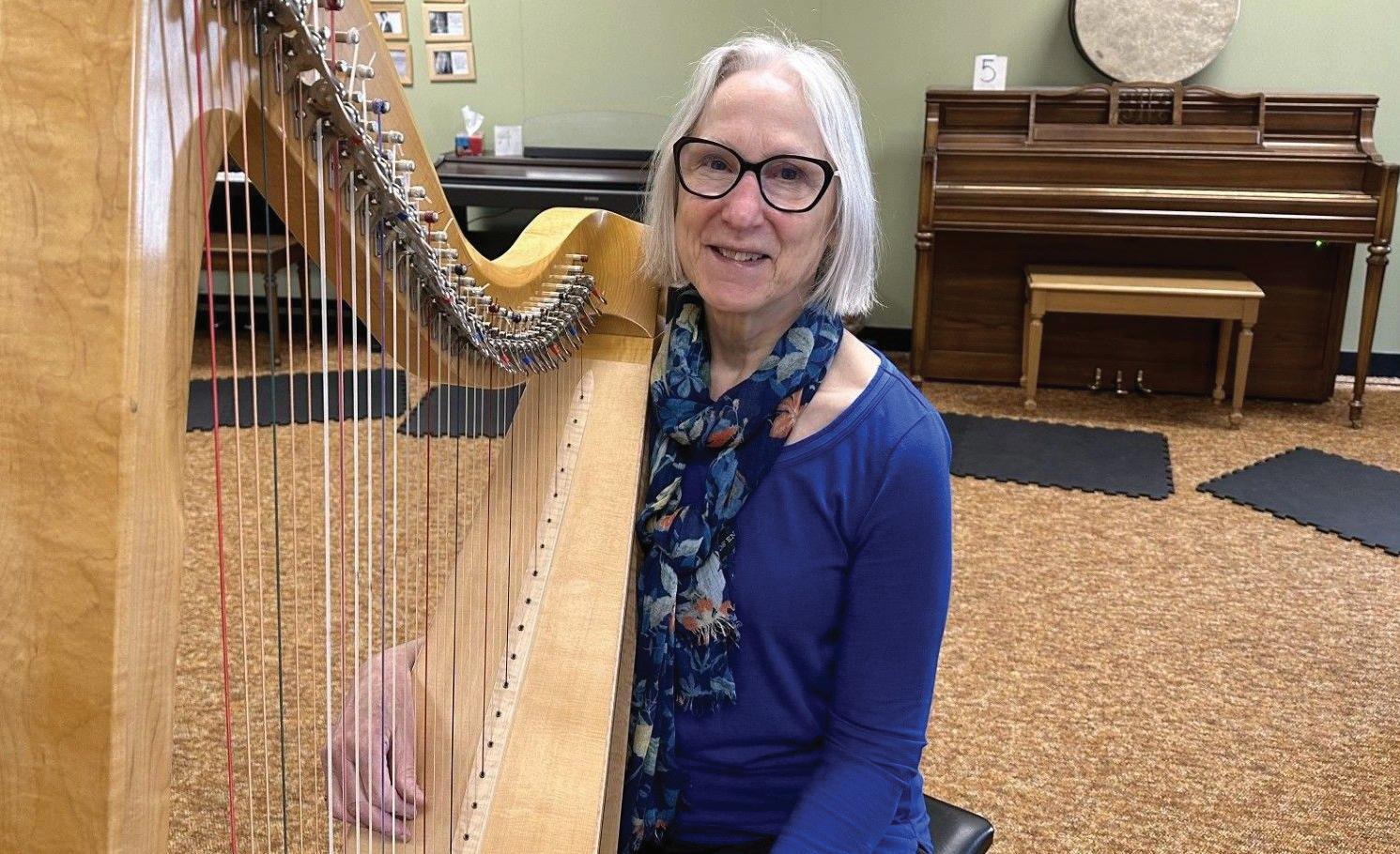
Still, she admits there are challenges to learning an instrument later in life.
“I watch children learning to play, and they just pick things up like that,” she said, snapping her fingers.
“It takes me longer to learn things, and that can be frustrating — remembering how I used to be and not being able to do the same things now.”
Then there’s the harp itself.
“My harp is heavy — probably about 30 pounds,” she said.
Godber, her teacher and the artistic director at the conservatory, chimed in to correct her: “It’s closer to 50 pounds, including the case.”
“Oh my gosh, no wonder!” Zimmer laughed. “It’s a big thing to heft around, but I can still do it. I may need a dolly at some point. For now, I load it into my SUV. It’s heavier than it used to be, and that’s a challenge — but mostly, the harp is just fun.”
Finding time and motivation to practise can be hard, she added — “but that was true even when I was a kid taking piano lessons.”
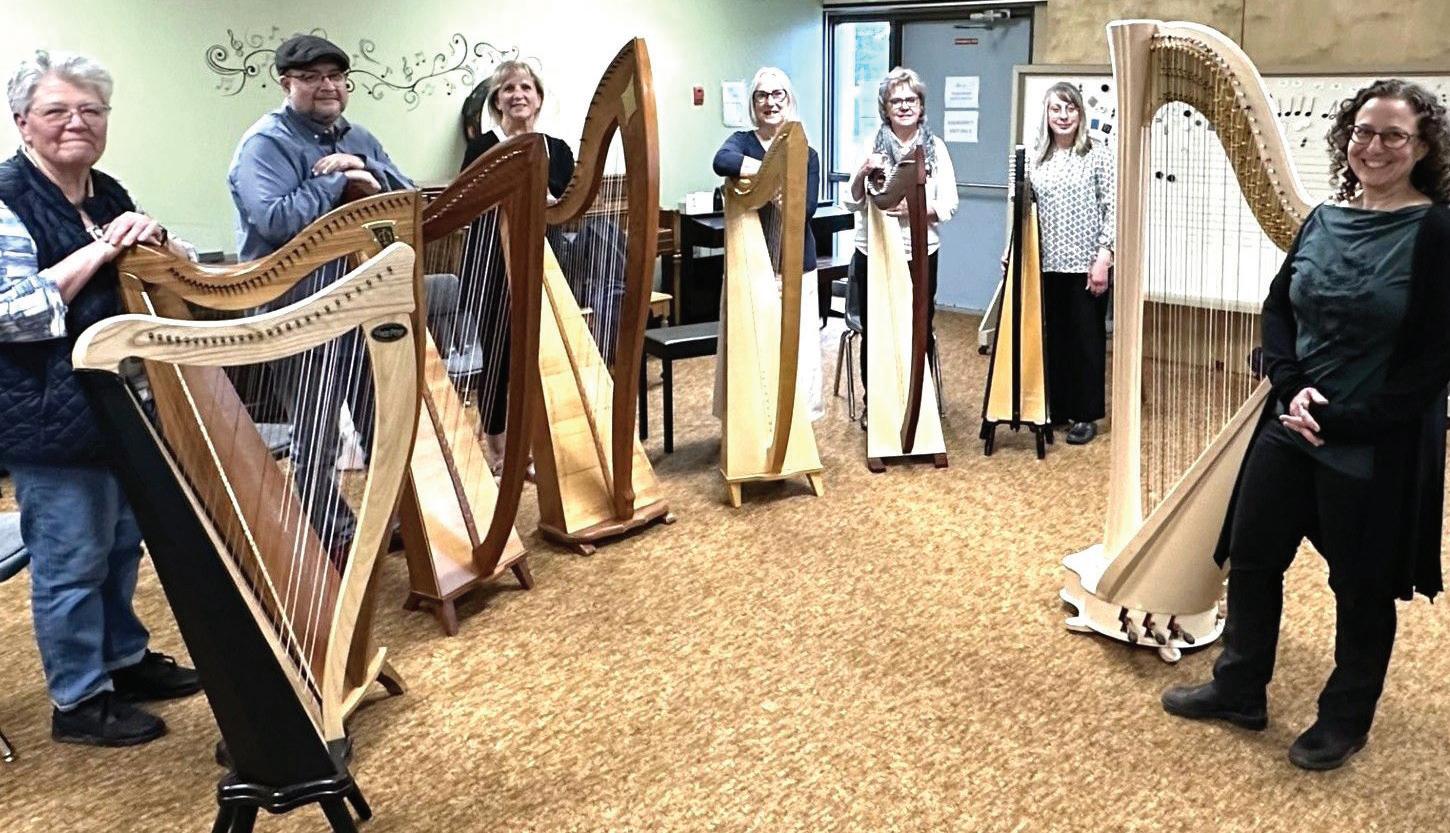
This is the Prince George Conservatory of Music’s Harp Ensemble that goes twice a year during 10-week sessions. Shoshanna Godber, far right, is the Conservatory’s artistic director and music teacher.
The Harp Ensemble helps keep her accountable. “You have to come together with others and keep up. You have to play your part,” she said. Her face lights up when she talks about the harp. “It’s such a beautiful instrument,” Zimmer said. “It’s such a
joy to make music. I’d love to play more perfectly than I do, but it’s still such a pleasure. Even if I’m not feeling motivated, when I sit down to play, I always feel uplifted. It gives me great joy.”
SEE ‘HARPIST’ ON NEXT PAGE
CHRISTINE DALGLEISH Citizen Staff
The Prince George Conservatory of Music held its annual scholarship competition on April 26 where students performed for an adjudicator, received detailed feedback and competed for monetary prizes to support their continued musical education.
This year’s adjudicator was Ken Hall, executive director of the PG Symphony Orchestra, whose thoughtful insights and encouragement were greatly appreciated by all participants.
There were nine scholarships totalling $2,550 that were awarded, thanks to generous donors.
These scholarships will be applied toward the students’ tuition for the upcoming academic year, offering meaningful support and recognition for their musical achievements.
This year’s scholarship recipients are:
Levels 1 & 2
• 1st: Jhade Raymundo (level 1 piano)
• 2nd: Corinn Reinheimer (level 1 violin)
• 3rd: Diane Ryu (level 1 violin)
Levels 3-5
• 1st: Daniel Tong (level 3 piano)
• 2nd: Hailey Tan (level 4
saxophone)
• 3rd: Adalyn Sinclair (level 4 piano)
Levels 6-9
• 1st: Larkin Imbao (level 6 violin)
• 2nd: Belinda Mou (level 9 piano)
• 3rd: Abigail Yin (level 9 piano)
The Grace Bosma and Mary Clare Lewis Award was presented to Larkin Imbao (level 6 vaiolin) as the top student in the Advanced category.
This special award honours the lasting contributions of Grace Bosma, the conservatory’s founding administrator, and Mary Clare Lewis, a long-serving board member and past president.
“The Scholarship Competition is a way for us to celebrate our students’ accomplishments and to honour the incredible individuals who helped shape the Conservatory,” said Shoshanna Godber, artistic director at the conservatory.
“It not only supports our students’ musical journeys but also strengthens the sense of community that makes our school so special.”
The conservatory extends its deepest thanks to all the families, donors and community members whose support makes opportunities like this possible.
For more information about the conservatory’s programs, scholarships, or how to support music education in our community visit www.pgconservatory. ca.

CONTINUED FROM PREVIOUS PAGE
Godber, who has been with the conservatory since 2012, teaches harp and several other instruments. She said interest in the harp has grown in recent years.
When the Prince George Symphony Orchestra (PGSO) received support from Fred and Daniella van der Post, along with a grant from the Prince
George Community Foundation, it was able to purchase a Salvi Daphne SE 47-string concert harp made in Italy — valued at over $20,000.
When not in use with the PGSO, the harp is housed at the conservatory and used for student lessons. Since its arrival, the number of harp students has grown to 15.
The harp is Godber’s instrument of choice.
“I love the sound of the harp, the immediacy of it. I love the feeling of having the harp on me, and I like that it’s unique,” she said.
At a recent concert, she recalled, “When they wheeled the harp onstage, the audience applauded.”
“We often say we just have to show up with the harp and people love it. They love to see it, to hear it — and many have never heard one live before.
I’ve been here 13 years and I still get that reaction.”
The Prince George Conservatory of Music is a non-profit music school and registered charity. It offers group and private lessons taught by professional performing musicians who are passionate about helping their students succeed.
For more information, visit pgconservatory.ca.
Dakelh speaker
Yvonne Pierreroy has been part of UNBC since before it opened
TED CLARKE Citizen Staff
Growing up on Nak’azdli Whut’en territory near Fort St. James with her parents and 11 siblings, Yvonne Pierreroy knew how to speak the Dakelh language long before she heard English spoken.
At an early age, her mother taught her the 46 sounds and double consonants unique to their language, and she had plenty of opportunity to learn how to make those sounds make sense.
Living off the land on Stuart Lake meant doing chores early on, and she grew up speaking her Dakelh ghuni language while working alongside her brothers and sisters picking berries, tanning hides, smoking meat and fixing fishing nets.
She didn’t realize it at the time, but she was preserving a language and culture that might otherwise be forgotten. For Pierreroy, that became her life’s ambition.
“The knowledge I carry comes from my parents — Mildred and Frank Martin — they were my teachers,” said Pierreroy. “I’ve always believed in the importance of sharing what I know with those who want to learn, so that Dakelh language and culture will continue into the future.”
Pierreroy always enjoyed school and learning new things, and it was while attending residential school from Grades 5 to 8 in Lejac that she started thinking about going to university to become a certified teacher.
She married soon after high school, and her responsibilities shifted to caring for her husband Ron and their son and daughter. She held on to the dream of earning a university degree, but it would have required two years of study at the College of New Caledonia and two more at UBC in Vancouver — a move she didn’t want to make with her family.
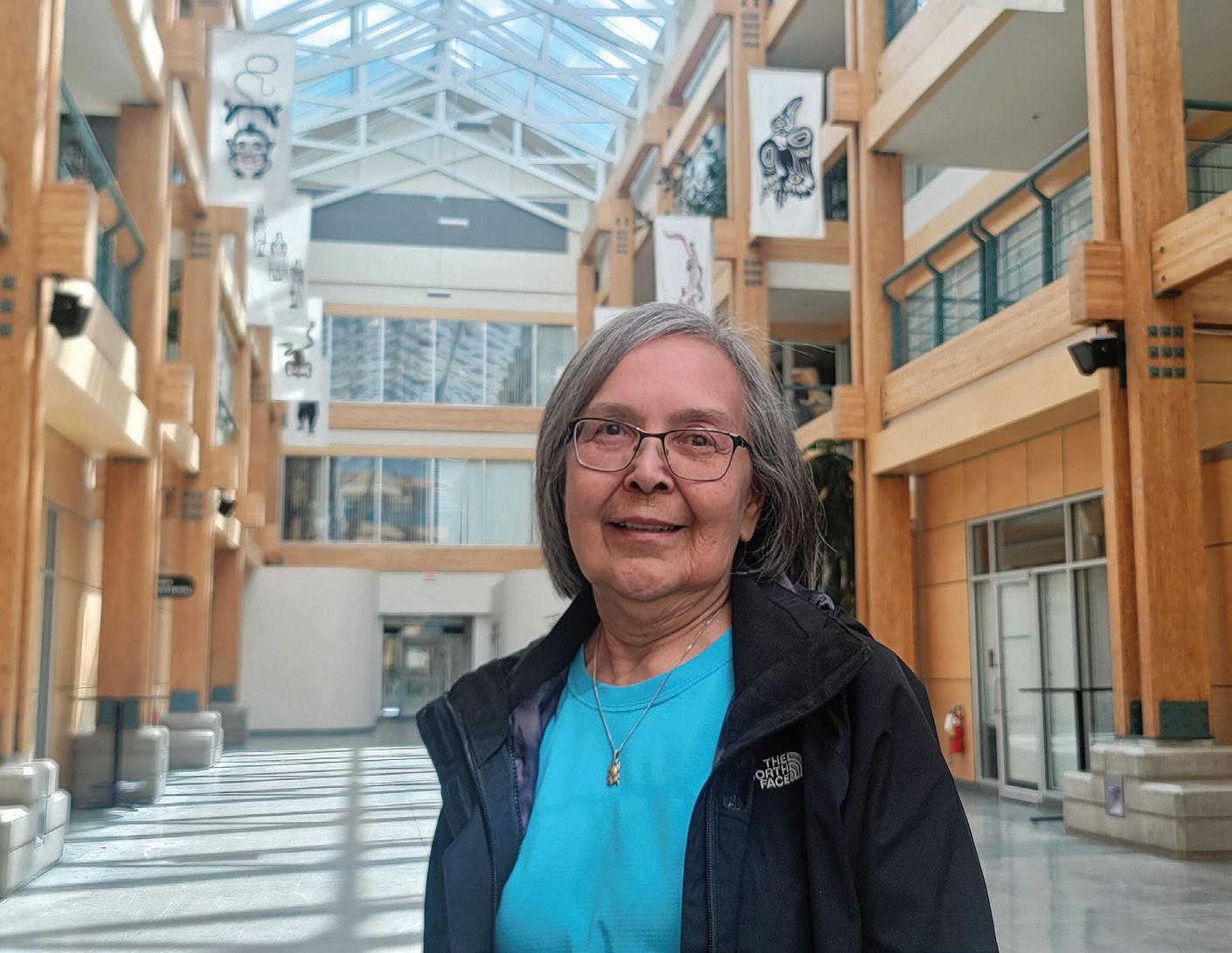
On Friday, May 30, at UNBC’s Brownridge Court, that dream will come true when the 71-year-old accepts her honorary doctor of laws degree.
It’s a reward for a lifetime of extraordinary efforts to preserve, revitalize and celebrate the Dakelh language — and a culture she vows will never be forgotten.
Pierreroy was the fourth oldest of the 12 children in her family, with two older brothers and an older sister, each born two years apart, followed by seven younger siblings born about a year apart. Her father, Frank, was a paddlewheel boat builder with extended family living in villages along Stuart Lake. As soon as school was out for summer, they packed up the kids to visit relatives — and they all spoke Dakelh.
“My dad built a house right across the street from the high school in Fort St. James, but Indigenous people weren’t allowed to attend public school, so I was sent to Prince George for high school in Grade 9,” said Pierreroy. “It gave me new opportunities. Basically, I left home when I was 10. Even though we went away for school, my parents were so rich in their language and
the language fast. Our younger generation is very interested now, and when we educate the public on who we are, then they understand better where we came from.”
Hired on April 28, 1992 — two years before the university opened — Pierreroy was part of the first intake of employees at UNBC. She worked for 17 years in the provost’s office, played a role in hiring faculty and administration, and worked with the board of governors.
During that time, operations were based out of downtown office buildings while the main campus on Cranbrook Hill was under construction.
In 1994, she enrolled in the first Carrier language course as part of the First Nations and Endangered Languages program. She was among the students from that inaugural class to suggest UNBC adopt the Dakelh Nak’azdli words “En Cha Huná” — meaning “respecting all forms of life” — as its motto.
culture, we kept it up. All my family are culture and language teachers now.”
That includes eight surviving siblings, including Nak’azdli Whut’en hereditary Chief Marvin Martin, as well as cousins and nieces who still speak Dakelh. Her mother, Mildred, and older sister taught the language for decades in a private school.
“I’m still sharing my knowledge after all these years, and now this is my degree — I feel very honoured,” she said. “There are so many people to thank: my mentors, my parents, my husband, my two adult children, all my siblings, my late aunt Catherine, who I co-instructed with here at UNBC, my cousin Nellie Prince in Prince George — we developed some curriculum together and taught some courses in the community.”
Although difficult for adults to learn, she says Dakelh is gaining traction with a new generation of students now being exposed to it in elementary schools.
“My language and my culture is who I am, and it’s important because we’re losing more of it,” said Pierreroy. “In the school, we start when they’re in nursery and still at that age where they pick up
Those words have become guiding principles for Pierreroy. UNBC has said she “has spent her life embodying the spirit of the motto through her deep respect for others, openness to diverse perspectives and passion for sharing knowledge.”
“When I started my employment with the university in 1992, I thought this is my opportunity to work and get a degree, so I started part-time studies,” said Pierreroy. “Five courses into it, I was asked to co-instruct the Dakelh Carrier language and culture course, so I put my dream aside. What I wanted to do was share my knowledge with students at the university, and here I am today — I am getting my degree.”
Pierreroy collaborated with UNBC and the Nak’azdli Whut’en Band Council to launch the Dakelh Language Certification Program in 2006. The initiative was designed to help Indigenous students transition from their home communities to academic life at UNBC. The program has since become a template for other First Nations learners preparing for university.
MATTHEW HILLIER Citizen Staff
Fishing Forever is a province-wide event sponsored by local game clubs and outdoor organizations that host events in their communities.
The local event in Prince George will be held on June 7 from 10 a.m.-3 p.m. and will be hosted by Polar Coachman of Flyfishers Associated at Vivian Lake Resort.
These events aim to help seniors and those with physical disabilities enjoy a day of fishing with the help of dedicated volunteers.
This includes learning to bait a hook and feeling the thrill of hooking and catching a fish.
“I would like to go fishing every day, but nature is not always wheelchair accessible,” said Fishing Forever co-chair Mike Stiles, VP of Accessible Okanagan.
“Having events like this, where people can get together and go fishing without any challenges, it’s an incredible opportunity for everybody.”
Fishing Forever has been in communities across the province since 1989. The initial idea was first put forward by journalist Walt Liimatainen.
Having events like this, where people can get together and go fishing without any challenges, it’s an incredible opportunity for everybody.”
Liimatainen had an award-winning career in broadcasting and was an avid and dedicated British Columbia outdoorsman.
One of the founders of the Fishing Forever organization, he passed away in Prince George on Aug. 21, 2009. No fishing license is required for the event and it will include a barbecue lunch, free rod and tackle loans and children’s fishing clinics.
The event is also looking for volunteers.
Visit bcwf.bc.ca/volunteer to find out how to help out at the June 7 event.
To participate in the event, email One612@telus.net.
Vivian Lake Resort is located about 40 kilometres northwest of Prince George.

fishing.
As a member of the Carrier Linguistic Society, Pierreroy worked with other speakers to revise the Dakelh dictionary and produced books, recordings, digital tools and online platforms to keep Dakelh traditions and culture alive. She also wrote a user-friendly, interactive Nak’azdli phrasebook for medical students and healthcare professionals to help them communicate with Dakelh-speaking patients.
A Dakelh elder, Pierreroy is also known as a gifted artisan, using her skills in beadwork to create clan vests,
wedding mukluks and button blankets.
“Teaching others how to bead or make moccasins is about more than crafting — it’s about connecting to culture in a hands-on way,” she said.
“Every stitch holds meaning, and when I share those skills, it’s another way to pass on knowledge in a meaningful way.”
She credits her strong family upbringing for giving her the foundation to succeed as a well-educated academic dedicated to teaching and preserving the traditions that define her culture.
“I’ve never done this work alone,” said Pierreroy. “My 97-year-old mother,
Mildred Martin, has always been beside me, as was my late father Frank — passing on knowledge and guiding me. My husband Ron has supported and worked with me every step of the way. We’ve always worked in tandem, and I’m grateful for their strength, love and commitment to our culture.”
UNBC president Geoff Payne said Pierreroy’s 35-year connection to the university and her dedication to the First Nations and Endangered Languages program make her a natural choice to be honoured at the May 30 graduation ceremony.
“It was a way to recognize everything
she’s done to accomplish her dream, and we’re happy we can do this and really highlight the amazing person she is and the contributions she’s made,” said Payne.
“It’s about leading the way and people following her — seeing what you can accomplish and being a beacon for the next generation,” he said. “When you think about where the university is in terms of truth and reconciliation, and trying to embody all the things Yvonne has spent her life advocating for — she’s absolutely the perfect person to receive an honorary degree from UNBC.”
CHRISTINE DALGLEISH Citizen Staff
Nations Rising, A Nisga’a Story, is a recently released documentary that explores the Nisga’a Nation’s remarkable history of resilience and the vision behind their company, Nations Royalty, Canada’s largest majority Indigenous-owned public company.
Nations Royalty is leveraging new tools and resources to help Indigenous peoples gain access to capital markets to create sustainable wealth to strengthen their communities for generations to come.
In the past the Nisga’a Nation fought for British Columbia’s first modern day treaty.
A landmark in the relationship between Canada and its Aboriginal peoples, the treaty came into effect on May 11, 2000, marking the end of a 113-year journey. When the Nisga’a Final Agreement was signed the Indian Act ceased to apply to the Nisga’a people.
The Nisga’a Final Agreement is the first treaty in British Columbia to provide constitutional certainty in respect of an Aboriginal people’s Section 35 right to self-government.
It recognizes Nisga’a Lands and opens the door for joint economic initiatives in the development of the Nisga’a Nation’s natural resources, it says on the Nisga’a Lisims Government website.
In the documentary Brian Tait, former executive chair, Nisga’a Lisims Government, said all the chiefs made a decision to work together, knowing solidarity equals strength, as they gathered to negotiate the Nisga’a Final Agreement. The same could be said for the development of their company, Nations Royalty.
The documentary showcases compelling insights shared by Nisga’a Nation elders, Nations Royalty executives and investment professionals.
“We’ve moved into an age of technology and innovation,” Tait said.
“Nisga’a has always been part of the leadership for innovation. We’ve always done these things first like the Treaty. Now these major projects with

Nations Royalty will generate a lot of resources for our future leadership and so for us right now — today’s leadership — we have to ensure that future leadership has all of the tools to manage wealth.”
Nations Royalty is the tool to get the Nisga’a Nation and other Indigenous groups to their vision of independence, whatever that might look like for them, said Kody Penner, vice president of corporate development for Nations Royalty.
“The documentary is about hope, it’s about working towards independence and it’s about the struggle that all Indigenous people have faced so I think it connects with everybody,” Penner said.
“Nations Royalty looks to pool Indigenous wealth through mining impact benefit agreements so the financial payments through those go into a public company to give Indigenous people access to their economic sovereignty.”
The company follows the traditional mining royalty business model, which has been done for more than 30 years and many companies follow it, Penner added.
“It’s been very, very successful,”
Penner said.
“It’s given their shareholders returns that are much higher and we follow that same business model but we’re doing it for the first time ever in the Indigenous space. So there’s never been an Indigenous-owned company, let alone an Indigenous-owned royalty company. So what we look to do is to partner with Indigenous groups from across Canada and potentially internationally, by trading or exchanging payments that they would normally receive from a mining asset now and into the future for ownership in Nations Royalty today. As we bring on more partners and we get more payments coming in from different mines across Canada we hope and expect that our valuation will rise just as other companies have and we can create a very strong, highly valued, royalty company with a bunch of Indigenous ownership from different parts of Canada and provide long term stable financial returns for our shareholders who are primarily Indigenous.”
The documentary was a joint effort between Nisga’a Nation and Nations Royalty.
“Frank Giustra is one of the main shareholders of Nations Royalty,
head of Fiore Group and is one of the cofounders of Lionsgate Studio,” Penner said.
“Frank has a great vision for storytelling and the great impact of it and same with the Fiore Group’s Rob Mcleod, who grew up in Nisga’a Territory, and has a long history with their leadership. He got together with them and they decided that this was the best way to tell their story because it is such a unique and cool initiative that’s never been done before. We needed to get it across to people in a way that truly uncovers why they did this and the struggles that they went through as a nation because it connects with other nations.”
Creating Nations Royalty was such a progressive move, Penner added.
“This story has to be told because of the magnitude of this,” Penner said.
“This has never been done before. There’s never been an Indigenous group that’s like this. The documentary was the best way to tell the Nisga’a story and why they would take this leap towards independence.”
To view the Nations Rising documentary visit www.youtube.com/ watchNationsRising.
MATTHEW HILLIER Citizen Staff
Electric vehicle drivers and supporters met with Denim “The Hummer Guy” Morrison and Doug Beckett, president of the Prince George Electric Vehicle Association, to discuss the benefits of EVs during a session on the University of Northern BC campus Tuesday, May 13.
Morrison, an EV salesperson at Wood Wheaton Supercentre, gave a presentation on the evolution and adoption of electric vehicles and current market trends, and shared various success stories and case studies.
The event was organized by Beckett, who also leads the Energy Transition Group, an initiative founded by individuals from UNBC and the Prince George Electric Vehicle Association (PG EVA).
The presentation concluded with Morrison, Beckett and attendees showcasing their electric vehicles — including a one-of-a-kind Mazda Miata that was converted into an EV using a motor from a 1999 Ford Electric by its owner, Jeff Anderson.
After the presentation, Morrison spoke with The Citizen about emerging EV trends in Prince George.
“It’s the cost of ownership,” said Morrison.
“Especially for the middle class and the working poor. Not having to shell out $100-plus to get you through a couple of weeks. Whereas your gas station is your house with an EV — it’s like leaving your house with a full tank of gas every single day.
“To charge up my 65-kilowatt-hour battery, it costs me nine dollars, and that gets me 400 kilometres. I’ve been on a 3,000-kilometre road trip, and the whole thing only cost me $190 — which messed with my perception of how expensive things are nowadays. Yeah, do I drive 400 kilometres or buy one watermelon?”
According to Morrison, EV sales at his dealership are up by 15 per cent. He sees trends emerging across northern BC when it comes to EV adoption.
Morrison also shared his current
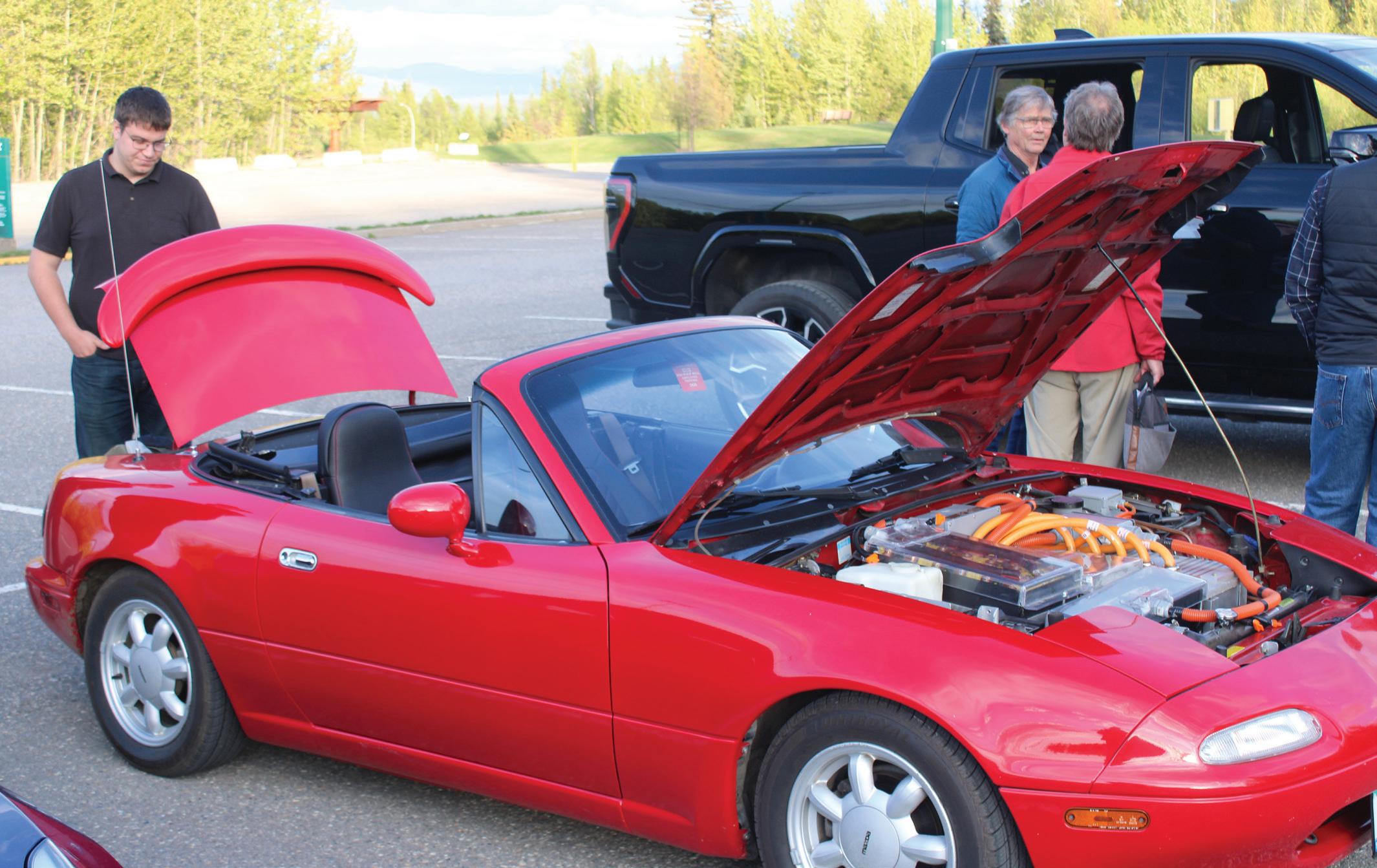
favourite EV with The Citizen — which, given his nickname, comes as no surprise.
“The Hummer EV — that thing is a technological marvel,” he said. “It is Mecha-Godzilla with wheels. It’s one of the coolest things General Motors has put out in the last decade.”
Beckett, the event organizer, is a strong advocate for the energy transition and EV adoption. He spoke with The Citizen about the benefits such a shift could bring to northern communities.
“It’s going to make the cost of living easier,” said Beckett.
“The electric transition technology is so efficient. It means local democracy for our power — you can make your power in your backyard.
“We can rely on local power. We don’t have to rely on power that’s being produced for other provinces or countries. Power won’t necessarily be dominated by big corporations like oil and gas.
“There’s less pollution involved
— 15,000 people a year die prematurely because of air pollution. Quality of life and health are going to improve for people. You won’t have as much asthma. You’re going to have fewer emergency room visits in hospitals, so our taxes will be less, or we can put the same money into providing more doctors and nurses and fulfilling the shortfalls in our health system. It’s just transformational. It’s going to lead to significant improvements all over.”
Despite his support for electrification, Beckett expressed concern about BC Hydro’s Site C dam.
“I wasn’t in favour of Site C because it’s very expensive electricity, and I knew that right from the get-go,” he said.
“For example, the new wind power projects BC Hydro signed on to in 2024 — they’re producing roughly the same amount of electricity as Site C for half the cost. It’s way less expensive per kilowatt hour for customers to buy.
“In that sense, I thought Site C was not

a good move. You want hydroelectric in your grid system because you can turn it on and off fairly quickly. But do you need 98 per cent hydro? Can 30 per cent do?”

May 22, 1986: Three Conair air tankers were kept at the Prince George Airport, ready to take off in case of a forest re. The area had just had some wet weather, helping the effort as 20 res were extingquished and, as of this date, no new res were reported in the area. CITIZEN FILE PHOTO BY BROCK GABLE

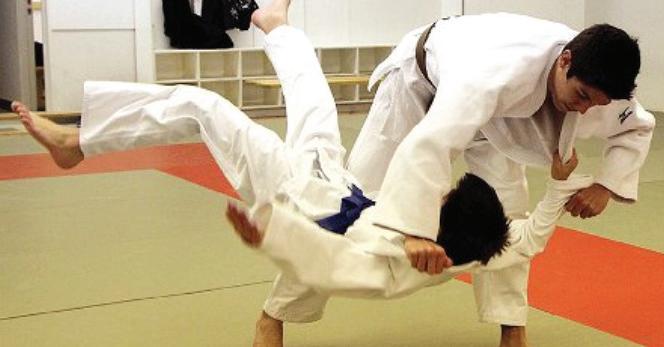
May 22, 2012:

May 20, 1965: Tom Burns, a. member of the city works department, was kept busy tacking up jubilee ags around the city. Prince George was set to celebrate 50 years since its incorporation as a city. CITIZEN FILE PHOTO
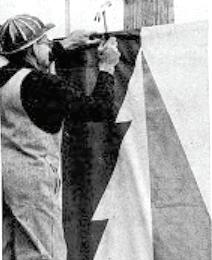

$6,000 JACKPOT

$4,000 cash plus $2,000 Slot Free Play $300 Regular Games $600 Double Win Regular games $2,000 $200 Slot Free Plays X 10 Draws
SATURDAY, JUNE 14TH 6:00 PM Evening Bingo
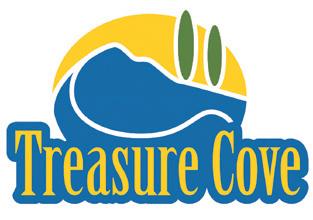


Know your limit, play within it.



Panel looks at stigma farmers and others in rural areas may often encounter
MATTHEW HILLIER Citizen Staff
Rural Minds Matter, operated by the Stigma-Free Mental Health Society, recently made a stop at the Connections Clubhouse in Prince George to open up conversation about the impacts of mental health on rural communities.
The event featured guest speakers Mike Skrypnek of the Stigma-Free Mental Health Society and Wendy Bennett of AgSafe.
They were joined by panelists Stella Suhr, a project planner for programs and quality assurance at the College of New Caledonia (CNC), and Gillian Johnson, a Grade 7 teacher in School District 57.
Speakers and panelists shared their personal experiences with mental health, discussed how isolation and lack of support affect rural communities, and outlined the barriers many rural residents face when seeking help. They also addressed the personal and communal stigma farmers and others in rural areas often encounter — including the potential financial and emotional cost of taking time away from work to seek treatment.
“All the things that make it great to live in a small town — like that individualism, that ruggedness, that self-reliance — they hurt you when you’re struggling,” said Skrypnek. “You’re not wanting to talk about it with anybody. Then suddenly you’re like, ‘I can take care of this myself,’ until it’s a real problem. Then it becomes a crisis, and you might have the propensity to harm yourself through substance abuse or direct harm, or harm others through your actions — either abusive actions or messing up at work.”
Skrypnek noted that two key types of barriers prevent rural residents from seeking help: structural and cultural.

“The structural things are geography. It’s just sometimes a two-hour drive,” he said.
“It could be that there’s a lack of resources. Therapists are not here, counsellors are not here, or maybe primary care physicians to introduce you to those people are not here. So those structural and geographical things are challenging at first. Then the cost of logistics can be overwhelming.
“If I leave my small town to go into the bigger town for a support appointment, and then that appointment gets bumped two days, I’m probably staying.
Now I’m staying overnight, I’ve done the drive, I’ve lost the work time, and I’m away from my family. I might not be able to pay rent next month because I spent three more days where I wasn’t supposed to be.
“Then you add on the stigma of talking about mental health — admitting you have a problem openly — when rugged individualism is the way you survive in a tough rural area. Then you’re telling people, ‘I’m weak and vulnerable,’ or at least that’s our perception.
When culturally that’s not acceptable, suddenly we have another reason not to go for help.”
The panelists emphasized that building and relying on community support is one of the most effective ways to address these issues.
“We need to take care of each other,” said Bennett. “Having peer support, having small communities getting together to watch out for individuals, getting to know your neighbours, and having community plans.
“Knowing that when the guy shows up at the coffee shop every Monday at eight o’clock and he hasn’t been here for the last couple of weeks — maybe something’s going on. Or your neighbour whose lawn is always meticulous and perfect, but it hasn’t been mowed in four or five days — ask why it’s like that. Having something in place so you feel safe to have that conversation and say, ‘Hey, are you okay?’ Because a lot of people don’t ask if others are okay — they’re afraid of the answer.”
Bennett has travelled across BC
visiting rural communities and searching for ways to help. She shared one of the most impactful stories from her time at AgSafe.
“I have one farmer in the Lower Mainland who lost two barns of chickens to avian influenza,” she said. “His whole barn became infected. They had to depopulate the barn — that was very traumatic for him. Then it happened again, and then he lost a friend to suicide.
“Because AgSafe was able to offer counselling for him at no charge, he found a counsellor that suited his personality and treatment style. He called me a couple of weeks ago and said we basically saved his life — because otherwise he wouldn’t have had access to counselling. No chickens, no money — he wouldn’t have had the ability to fund the care that he needed. But because we had a program in place, he called to let us know he was back on his feet, and that we probably saved his life.”
Learn more at stigmafreementalhealth.com/campaigns/ rural-minds-matter/
ANGELA KEHLER Northern Health
May 12–18 was National Nursing Week, and this year’s theme was The Power of Nurses to Transform Health. The theme recognizes the tremendous impact nurses have on individuals, communities, and the future of health care.
Today, we’re highlighting three employed student nurses (ESNs) who are currently on their educational journeys to becoming nurses.
Ujay Enemuo, graduate, Practical Nursing Program, College of New Caledonia – April 2025
How would you describe your personal and professional transformation throughout your educational journey?
“I’ve spent a good part of my adult life in the classroom – both as a learner and as a teacher in my home country of Nigeria.
“However, nursing school has been the toughest educational journey I’ve ever taken. Starting over in Canada as an internationally educated adult learner came with many layers of struggle. I was adjusting to a new environment while also facing the challenges of being an international student. Through it all, the fulfillment of my dream to become a nurse gave me purpose and direction.
“Nursing is demanding, and for me, it came with added pressure. The backto-back assignments, heavy course content and strict grade requirements caused a lot of anxiety. I have never studied this hard in my life. I’ve lived on coffee, never missed a class, used every available resource and stayed close to my instructors, who were always supportive.
“Every lecture, lab practice, clinical shift and challenge became part of my growth. I learned not just the science of nursing, but the art of resilience. Today, I’m proud to say I’ve fulfilled a childhood dream of caring, and I now stand at the threshold of giving back through the very profession that helped me rebuild my life.
“My confidence has grown through


my experience in the surgery unit as a student nurse, and I believe I have the qualities it takes to be a good nurse: compassion, empathy, patience and the ability to truly listen.”
Layla Morrow, graduate, Northern Baccalaureate Nursing Program, UNBC Fort St. John – April 2025
What motivates you to continue in the nursing profession, especially during challenging times?
“I chose nursing because I needed a career that would be deeply meaningful. Even on the hardest days, the ability to show up for someone in their most vulnerable moments makes every shift worthwhile. The impact of our work isn’t always found in big wins, but in the accumulation of small, meaningful actions.
“Nursing is never just about tasks –it’s about compassion, presence and support. I’ve leaned on the encouragement of my instructors, mentors and co-workers throughout my journey, and I’ve been glad to offer that same support to others.
“Having just completed nursing school and worked as an employed student nurse, I can confidently say that what sustains me is the incredible

team-based environment. I’m entering a profession — and a unit — that values collaboration and camaraderie, and that makes all the difference.”
Shallah Luis, third-year nursing student, University of Northern British Columbia, Terrace
Can you describe a moment when you felt that your work as a nurse made a significant impact on a patient’s life?
“I had the privilege of caring for a palliative patient during his final days. He needed help regularly with personal care and mobility, and often felt isolated.
“I vividly remember one moment when I checked on him and found he had fallen while trying to get to the
washroom. When I asked why he didn’t ring the call bell for assistance, he said, “I don’t want to be a burden. I know you’re busy, and I should be able to care for myself.”
“I reassured him that my role was to support him, and that he could ask for help with anything. The night before he passed, I brought him his favourite ice cream from the kitchen, sat at his bedside and chatted with him until he fell asleep. His family repeatedly thanked me for the care I provided. While this is my job, it was fulfilling to know the care I gave was genuinely appreciated and valued by both the patient and his family.”
How do you see the role of nurses evolving over the next decade, particularly in the context of transforming health care?
Enermo: “In the next 10 years, I believe nurses will be seen more than ever as leaders, educators and strong voices for change. Nurses already do so much more than bedside care – we guide patients through the system, teach them how to care for themselves and speak up when something needs to change. This role will only grow stronger.”
Morrow: “Nursing is evolving rapidly. I’m excited by the expansion of education, scope of practice and nurse-initiated protocols. While the shortage of health-care personnel is a real challenge, it’s also a catalyst for innovation. I feel fortunate to be starting my career in the emergency department – a specialty area that historically didn’t take on new graduates. That shift reflects the profession’s growing recognition that, with the right support systems in place, nurses can adapt, lead and thrive in high-acuity settings early in their careers.”
Luis: “In the coming decade, nurses will continue to advocate for patient rights, promote health and independence, and integrate evidence-based practices. I envision the role of nurses becoming more multifaceted, with an increased emphasis on preventative care delivered through community-based nursing and home care.”


TED CLARKE Citizen Staff
Josiah Wilkinson’s triathlon career is taking off — literally.
Fresh from winning the Apple Blossom sprint-distance event in Kelowna by a country mile a couple of weekends ago, the 18-year-old from Prince George is set to jet off to Europe for his first taste of international competition. Junior elite races are lined up in Austria, the Netherlands and Hungary.
“I’ve never raced outside of Canada,” Wilkinson said.
Currently ranked seventh in the country, Wilkinson is expected to climb higher in the national standings in his final year as a junior before moving up to the under-23 category. His results in the three European events will serve as qualifiers for two additional races. His first race is June 14 in Wels, Austria.
On May 4 in Kelowna, Wilkinson won the overall sprint title by more than seven minutes over the next closest competitor in a field of 249, finishing the course — an 800-metre swim, 20-kilometre bike and five-kilometre run — in 1:01:54.
“The race plan was just to go hard in the swim, then kind of go at a comfortable pace but still push it in the bike and run just to see where the legs were at — there was no plan for a podium, it was just kind of an icebreaker,” said Wilkinson, who now trains out of Victoria. “It was awesome that I got on the podium anyway, just following the race plan. It feels pretty good. I’m pretty happy about it.”
Wilkinson spent more than half his life training and racing with the Prince George Barracudas Swim Club.

“My swim has always been decent. I was a club swimmer for 10 years, so the past couple of years I’ve been mostly focusing on running and biking,” he said. “But definitely this season I knew I had to pick up my swim to compete with the guys in Europe.”
Wilkinson hopes to continue building his sprint résumé en route to a future Olympic bid. He also has his sights set on standard-distance pro events (1,500metre swim, 40-kilometre bike, 10-kilometre run) and eventually the Ironman distance.
“It’s a long process. It will probably take eight to 10 years (to reach the Olympics),” Wilkinson said.
He’s met Simon Whitfield several times at training camps in Victoria.
Whitfield, a four-time Olympian, won gold at the inaugural Olympic triathlon in 2000 and silver in 2008.
“He’s a super down-to-earth guy and he explains what it takes to get there,” said Wilkinson. “It’s just kind of cool seeing those guys around.”
This summer, Wilkinson plans to compete in the junior national series, culminating with the junior national championship in Montreal in September. A top-two finish in the national points standings would earn him a spot representing Canada at the world junior championship in Wollongong, Australia,
on Oct. 17.
Now in only his third season as a fulltime triathlete, Wilkinson got an early start in the sport thanks to his father, Clayton, a triathlon coach. He introduced Josiah to the sport through the Prince George Kids Triathlon.
Josiah says one of the toughest aspects of elite racing is balancing training in all three disciplines, but his experience on the junior development national team has helped.
“Time management is a huge part of triathlon because you’re trying to get as good as you can at three different sports,” said Wilkinson, a 2024 Prince George Secondary School graduate. “You have to be able to do a full workout every day, go to school or work, and then spend time with your family and friends. The days are pretty packed with not a lot of downtime, but you get used to it.
“I like the challenge of it. Every day it’s like, man, do I really want to sit on my bike for three hours? But I kind of like pushing myself and seeing what my body’s got — seeing what my limits are and pushing them. That’s probably what I enjoy most.”
Wilkinson works part-time at McDonald’s and at Cycle Logic bike shop in Prince George, and both jobs help support his triathlon career. Cycle Logic sponsors him through its ambassador program with free cycling gear, and McDonald’s offers food discounts that help fuel his five-foot-nine, 155-pound frame. He tries to make healthy choices, opting for chicken sandwiches and salads.
“Cycle Logic are the best guys — they set you up, and they’re all bike racers, so they’re super supportive,” he said. “I try not to (eat hamburgers). How bad can chicken be for you?”
SEE ‘NORTHERN’ ON NEXT PAGE
Easton Santos, 7, takes Daxton Farwell, 7, to the mat as they grapple in the 6-7 year-old 50lb class at the Northern BC Combat Challenge held at PGSS Saturday, May 17. The day brought several combat sports disciplines together, including jiu jitsu and wrestling, with youth and adult competitors. The day was held in the memory of MMA fighter Travis ‘The Gladiator’ Galbraith, who died last year in a rafting incident on the WIllow River. Combatants were drawn from different martial arts schools, and used different forms of grappling-based martial arts to compete. While MMA also includes striking — hits with hands and feet — that was not part of this tournament.
CONTINUED FROM PREVIOUS PAGE
As lean as he is, Wilkinson jokes that sometimes he wishes for a bit more insulation during the cold race season.
“I’ve put on a bit of muscle just from swimming and riding the bike, but I’m super lean,” he said.
“As soon as race season comes up, I have almost no body fat and I get cold super easy.”
The cold didn’t slow him down in February when he placed second overall for the second straight year at the Prince George Iceman — a multisport endurance race featuring cross-country skiing, running, skating and swimming.
Wilkinson began open-water swim training this week in Victoria and also trains at West Lake. His father launched the Northern Triathlon Club two years ago and revived the Prince George Northern Triathlon, which starts and finishes at the Aquatic Centre. This year’s event is scheduled for Sunday,


June 1.
The Northern Triathlon Club had a strong showing at the Apple Blossom event. Four of the 12 club members who raced in Kelowna placed first or second
in their age groups.
Northern club athletes adapt to Prince George’s winter conditions using treadmills and the indoor track at the Northern Sport Centre. They also train with indoor bike trainers equipped with simulation software.
“Everybody’s been training hard over the winter,” Josiah Wilkinson said. “I don’t think anybody had any expectations to get on the podium, but it was definitely a good surprise that we could go down there and do well.”
It was Levi’s best triathlon result to date.
Jonathan Taylor was first in the men’s 40-44 division (fourth overall, 1:10:19). Anna De Wynter won the women’s 20-24 division (third overall, 1:18:49). Aleza Cartwright finished second in women’s 16-17 (1:31:08). Levi Wilkinson, Josiah’s 14-year-old brother, was second in the male 14-15 youth course (35:33).
“At the BC Summer Games last year, he had a great time but was a little disappointed with his result. And this year — first race — he gets second. He’s been working hard, and that’s awesome.”
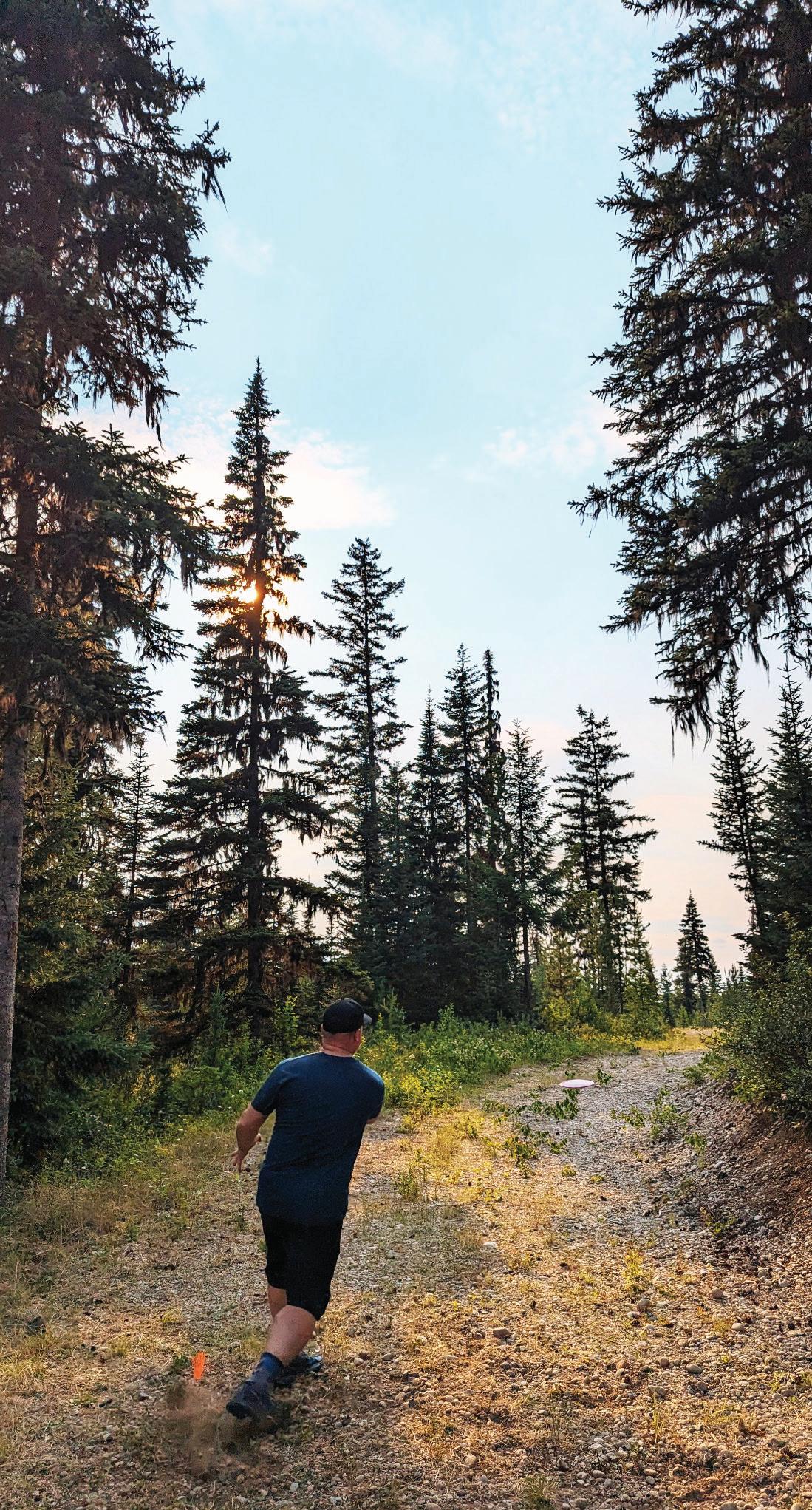
CHRISTINE DALGLEISH Citizen Staff
Still affected by a car crash spinal-cord injury, Dion Eden, president of BC Disc Golf Association, knew he wanted to offer the Playing in My Shoes opportunity to anyone who wants to know what it’s like to be differently abled.
At Rainbow Park in Prince George on Sunday, May 25 from 11 a.m. to 2 p.m. and 31 other communities across Canada on the first day of Accessibility Week in Canada, people of all ages and abilities can see what it’s like to play disc golf from a wheelchair, using their less dominant hand, with earplugs, blindfolded or with a taped hand.
From the wheelchair it will answer the question of what barriers affect your play from a seated position. The wrong arm throw will show players how difficult it is to throw with your less dominant arm.
Blindfold throw will see participants try to find the basket without sight and the earplug throw will offer what it would be like to play with reduced or no hearing while a taped hand will demonstrate just how hard it is to throw the disc without being able to get a good grip on it.
This event is actively promoting inclusion and accessibility, an important aspect of everyday life for Eden, who can still play the game after his 2009 accident, it just looks a little different now. It took him a couple of years to get back to playing disc golf but as he began designing disc golf courses his own circumstances inspired him to think about enhancing accessibility.
“In 2022 I designed and installed a wheelchair accessible course in Keremeos, BC, where I live,” Eden said.
“That really got me rolling on the idea of making more courses more accessible.”
Disc golf was always a popular game but when the pandemic hit and social distancing was mandatory, people found the sport a perfect way to get outside while still interacting with people safely, Eden said.
“I want the message to get bigger,” Eden said.
“I want more courses to be accessible to create more diversity in the sport. The Playing in My Shoes event offers just a taste of what people experience with a different ability level. It’s really important to get the message out there because disc golf is a unique sport as you really don’t need to be mobile. If you’re not really quick on your feet you can still throw the disc and still have fun and that’s why I feel it’s more inclusive. As long as the course is accessible then that provides the inclusion and accessibility for everybody.”
Mike Trasolini, a member of PG Disc Golf, is helping to organize the local Playing in my Shoes event at Rainbow Park and said baskets will be set up near the utility shed across from Spruceland Community Arts School field so people can try the game with limited ability.
“We’ll be there to educate people that the sport is for everybody regardless of ability,” Trasolini said.
“It’s meant to be fun. It’s meant to be enjoyed by all.”
After that Trasolini said he will encourage people to stay and play the course.
“The disc golf community is very welcoming, very laid back, and you kind of have to have a bit of a sense of humour,” Trasolini said.
“You can’t take the sport too seriously when you’re an adult throwing a disc around a park, right? It’s got to be taken lightly. It’s a fun game, it’s relaxing and it’s social.”
There are several locations in Prince George where disc golf courses are set up including at College Heights Elementary School and Malaspina Elementary School and at the Caledonia Nordic Ski Club.
For more information about disc golf visit https://bcdiscgolf.ca/ or visit the all accessible disc golf Facebook page at https://www.facebook.com/profile. php?id=61556657785821 or Eden’s personal Facebook page at https://www. facebook.com/dee1man


















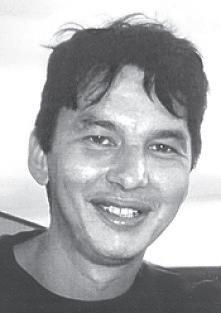

Eric Woyciehouski
July 18, 1972 -May 22, 2007
Always in our hearts, Forever in our Memory.
Love Mom, Dad, Kevin, Shari & Families
Ethel “Morgie” Gabriele
May 22, 1985
40 years ago today
Since you passed away Sometmes it feels like forever
Sometmes it feels as if never
Always remembered Always loved
Your Son,Warren
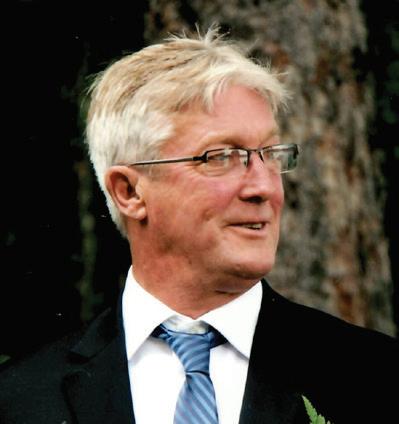
Geofrion Lee Milan ar ebr ary
eo assed away s ddenly ebr ary
e is s rvived by is lovin wife and so lmate ynn and is best friend i mo s e ial friends arol ord brot ers im am erri k iane sister in law e y Anne n mero s nie es and ne ews and many friends from an o ver sland to ewfo ndland all of w om e loved
eo loved t e reat o tdoors es e ially is abin at l l ake t was de nitely is a y la e e ad a e eart lled wit love
love yo ast t e moon
And miss yo beyond t e stars orever missed orever loved o will forever be a art of me ntl we meet a ain
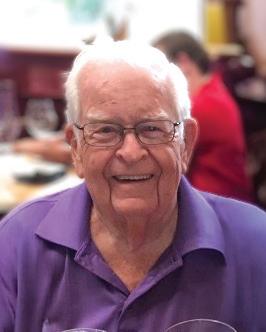
Robert Allan Husband
November 26, 1930 - April 11, 2025
It is with profound sadness to announce the passing of Robert Allan Husband. Just a great dad, grandfather and great-grandfather.
He is survived by the love of his life Michaela to whom he was married to for 72 years, son Bob Husband (Margaret), da ter endy i er oy several terri rand ildren and many great grandchildren, also, very special nieces and nephews.
Allan was born in 1930 and grew up in Victoria, BC. He was an avid lacrosse player in his youth and played m lt le s orts e be ame known as t e Silver o in t e handball leagues of Prince George for his wonderful silver air and is rowess at t e s ort e was a well known sin er wit a bea tf l dee voi e t at was nfor e able once heard. Allan and Michaela loved to dance, they had been dan in to et er sin e t e s and ntl is knees slowed im down Allan was always known as t e smoot est y on t e oor
e worked many years for ydro w i took im from Victoria to Prince George and also saw him posted overseas to some incredible places. Upon his return from overseas e t en moved into t e ositon of e tve ire tor of t e os ital in A very interestn areer e had indeed.
Allan took early retrement and wit i aela moved to t e kana an ook a t rn at a bed and breakfast establis ment and t en se led in Armstron w ere e and Michaela remained.
e will be so very missed by is family e wo ld like to t ank t e ama in sta at leasant alley anor e e ally ama in sta at eaton la e etrement omm nity Also t e steady and omfortn and of r ar er
Allan as re ested no servi e b t e will not be for o en by t ose of s w o loved im so m

January 29, 1938 – May 10, 2025
It is with great sadness that the family of George Harris share the news of his passing.
George grew up in Vancouver, Deep Cove and Murrayville. George married his high school sweetheart, Fay Deighton in 1961. They relocated to Prince George in 1964 where George worked as a teacher and later principal for School District 57 for 35 years. He was passionate about ed aton and is st dents
George and Fay raised three children Laurel, Lance and Lee and built their home on the Nechako River. Fay and George were married for 39 years when Fay assed away in e ember a er a o ra eo s ba le wit an er
eor e e erien ed a se ond love in is life meetn and marrying Beverley in 2003. They had 22 wonderful years to et er livin in t e ent ton area
Predeceased by his wife, Fay, parents, Murray and Edith Harris, sister, Marjorie Barichello and brother Doug Harris.
Survived by his wife Beverley, brother Ken (Janine) Harris, children Laurel (Paul) Kather, Lance (Leslie) Harris, Lee (Elizabeth) Harris, Bev’s children Michele Wilson, Andrea Sam i e ris at alie essent rand ildren and 4 great grandchildren and numerous nieces, nephews and in-laws.
Special thanks to the devoted nurses and doctors on the oor of ent ton os ital

n lie of owers lease onsider a donaton to t e ent ton os ital or t e arity of yo r oi e
A elebraton of life is lanned for ly

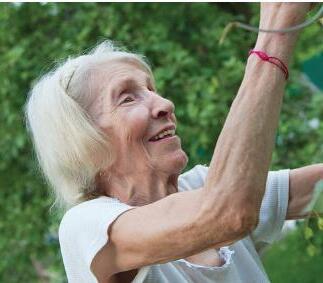
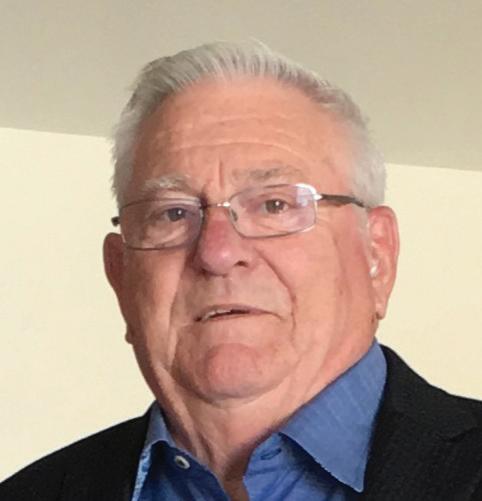
March 6, 1943 -May 12, 2025
With heavy hearts, we announce the passing of Stanley James DeMerchant, a man whose warmth and generosity touched countless lives in Prince George and beyond. Stan passed away peacefully on May 12, 2025, at the age of 82.
Born in Oliver, BC, and raised in Osoyoos, Stan’s early life included serving his country with pride in the United States Navy (1964-1968), with deployments to t e ietnam ar on swi boats. is life took a beautful turn in dne , ustralia, w ere e found is belo ed wife, Linda. eir remarkable ear partners ip was t e foundaton of t eir famil , w ic grew to include three children: Sharlene, Shawn and Steven whom they raised in Prince George. or e decades, tan s iesel er ice was a cornerstone of t e rince eor e truckin lo in communit . tan s dedicaton and onest work et ic earned im t e unwa erin trust and appreciaton of countless truckers. is later enture, e erc ant ruckin , and is own inspecton facilit furt er solidi ed is contributons to t e lo in communit , where he built many enduring lifelong friendships lea in a lastn le ac of reliable support. Everyone could count on Stan!
Beyond his professional endeavors, Stan was a familiar and ent usiastc face at t e race track in t e 1990s, sharing this passion with his two sons. tan s le ac is one of kindness, a stron work et ic, and enuine connecton.
e will be profoundl missed b is c ildren, arlene od , awn Carmen , and te en usan is randc ildren, an, ulia, omm , amant a and le Care is reat randsons an and a on and a wide circle of friends and famil . e ad so many lifelong friendships who will deeply miss tan, includin is unda Breakfast Club. e was predeceased by his beloved wife, Linda (2020), his two brothers Floyd DeMerchant, Dale DeMerchant, is sister ean ounds, niece Lori oo and two nephews Kenny DeMerchant and Wade DeMerchant e famil wis es to e press t eir sincere appreciaton to t e compassionate sta at t e rince eor e ospice ouse for t eir e ceptonal care, and to the many family and friends who provided comfort and support in is nal da s.
In lieu of fowers, t e famil kindl re uests donatons to t e rince eor e ospice ouse, a place of great comfort and care.
Celebraton of tan s Life will be eld on Sunday, June 15th, from 1:00 pm to 4:00 pm at the Prince George Civic Centre.

March 6, 1953 - May 5, 2025
Andy’s family is deeply saddened by our sudden loss. A kind, loving, humble man. We will miss you so much In lieu of fowers, donatons to Ness Lake Bible Camp would be appreciated.
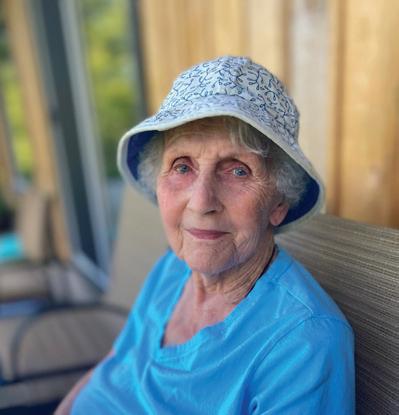
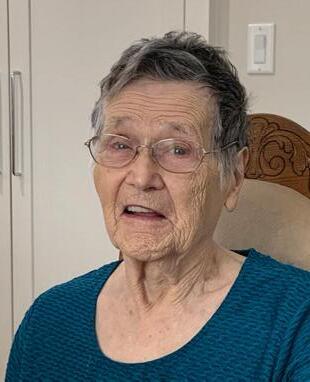
Mary Taylor
December 15, 1926 - February 5, 2025
Celebraton of Life onorin ar a lor, w o passed awa ebruar , , will be eld on ednesda , une , at at t e insmen all insmen lace . or ot er informaton, please isit www.di nit memorial.com.
August 11, 1932 – April 18, 2025
It is with profound sadness that we share that Joan “got her wings” on April 18, 2025. She never did have to go to “Shady Pines” due to the unwavering dedicaton of er carin son a id wit w om s e lived. She was Best Friend to her daughter Alexandra w o pro ided lo istcal support for oanie to sta at ome, and s e s ared a special bond wit er lo in son C arles w o in recent ears spent more tme wit t e l Bird in rince eor e t an in is own ome in elta. r. i ins, Linda, ei, ebbie, annon and utumn pro ided e ceptonal care to oan w o at stll ad er s arp mind, intelli ence and sense of umour.
In her last days, she listened to the creek roaring outside and was surrounded b t ose s e lo ed includin er son in law ike a el wit w om s e s ared a dr sense of umour, er tall, stron randsons omas mi umada and Nic olas, er muc lo ed and talented rst son oward ire of Vancouver, and the cats and dogs who wandered in and out of er room.
e was predeceased b er ood umoured usband tan in , er dearest friend innie ite in and er lo in brot er C arlie Co in . e will be deepl missed b er treasured sister at ell and lo in niece n ela in Cal ar , friends and e tended famil includin aria Brkic and elen sen. e en o ed u s Ni t on rida s w en all er Bo s includin obert reus and re or un ate would come to et er for a meal and watc .
oan was born in London, n land but, at a e , wit t e start of II, was e acuated wit er oun er sister to li e wit a kind famil in omerset for 6 years.
e recei ed er teac er trainin in t e and emi rated to Canada in , drawn b t e ock ountains and open skies. e married tan in asper and in t e mo ed to rince eor e w ere oan tau t se eral rades in t e one room Bonne ill c ool. e was a well respected rimar educator w o tau t in for nearl ears and, wit a few ot er pro ressi e teac ers, was instrumental in se n up t e pla based model of inder arten in elementar sc ools in t e earl s.
it tan, oan formed man friends ips in rince eor e and in t e abor Lake communit o er ears. e was appiest wit er famil en o in a peaceful life at t e lake cookin , bakin , pu erin in t e reen ouse, kni n , watc in n lis s ows, readin newspapers and politckin wit tan, drinkin co ee and s arin bakin and fres bread wit friends w o dropped b t e omestead on weekends. She relished trips to Vancouver to see her adult c ildren and spend tme wit er t en oun randsons readin and talkin . e instlled in all of us t e alue of educaton, curiosit , tra el, books, t e arts, desi n, music, famil , erita e and istor , civic duty, and love of place. A kind, gentle and enerous soul, oan alwa s saw t e best in e er one. ou ul and le el eaded, stron and independent, s e was an e cellent soundin board and made e er t in seem possible. oan li ed a ood life and lo ed us to t e moon and back.
Celebraton of oan s Life will be eld on ul t . lease email le andra at oan ul mail.com or te t er at for more informaton.
In lieu of fowers, please send a donaton to BC C ildren s ospital.






a e o e that ru e idd of idd e tures td. has fled ith the Chief ermi er u der e o of the i es A t . . .C. . a proposed mi e pla to ether ith a pro ram for the prote o a d re lama o of the la d a d ater ourses related to property ora da a d it lo ated at ora da d. ot A C pp ri e eor e C. A opy of the permit appli a o i ludi suppor do ume ta o is a aila le for pu li ie i at the e io al i es e ri e eor e C. A y perso a e ted y or i terested i this pro ram has days to ma e ri e represe ta o to the i istry of i i a d Cri al i erals o outh est e io al e o t ro o t i toria C or email outh est i es i isio o . . a ith a opy to ortheast Ce tral i i e io uite th A e. ri e eor e C. Appli a o i forma o a d i stru o s for su mi omme ts to the i istry are also a aila le o the i es u li a eme t ortal at . o . . a mi ese a eme t or s a the ode elo .

*On May 26, 1897, Bram Stoker’s now iconic horror novel “Dracula” went on sale in London. Stoker’s editors had deleted the first 101 pages from his manuscript and altered the text to seem less “real,” since there just so happened to be a serial killer known as Jack the Ripper on the loose in the city at that time.
* On May 27, 1949, the unemployed, 22-year-old model-actress Marilyn Monroe earned $50 for posing nude for a Los Angeles photographer against a red velvet backdrop. Though it became the most famous calendar photo in history, she never earned another cent from the picture, as she had signed away all her rights to it in a release form.
• On Nov. 11, 1831, Nat Turner, an American slave and educated minister who believed that he’d been chosen by God to lead his people into freedom, was hanged in Jerusalem, Virginia, for leading a revolt with 75 followers through Southampton County, killing about 60 white people.
ARIES (March 21 to April 19) You might not like some people’s ideas of surprises. But you could be in for a pleasant shock when someone fnally sends a reply to a request you made so long ago that you almost forgot about it.
* On May 28, 2005, Carl Edward Roland, who was wanted by police in connection with the murder of his ex-girlfriend Jennifer Gonzalez, was removed from a crane perched 18 stories above a construction site in Atlanta, where he’d spent three days.
• On Nov. 12, 1969, investigative journalist Seymour Hersh revealed the extent of the U.S. Army’s charges against 1st Lt. William L. Calley at My Lai, Vietnam, in a cable picked up by more than 30 newspapers, saying that “The Army says he [Calley] deliberately murdered at least 109 Vietnamese civilians during a searchand-destroy mission in March 1968, in a Viet Cong stronghold known as ‘Pinkville.’”
TAURUS (April 20 to May 20) It’s a tme to expect the unexpected. So, don’t be surprised if a decision that just recently seemed fnal suddenly opens up and leaves you with another chance to make an important choice.
GEMINI (May 21 to June 20) Taking a diferent tack on a work project might rankle some colleagues. But the positve results of your innovatve course soon speak for themselves. Celebrate with a fun-flled weekend!
After his capture, he was eventually found guilty of first-degree murder and sentenced to life in prison.
* On May 29, 2014, transgender actor and advocate Laverne Cox appeared on the cover of TIME for its story “The Transgender Tipping Point,” following a public backlash over the magazine’s exclusion of Cox from its 100 most influential people reader’s poll the previous month.
* On May 30, 1993, after being stalled for four days by a blizzard 4,000 feet below the summit, Joni Phelps became the first blind climber to reach the top of Denali, North America’s tallest mountain. She was guided

CANCER (June 21 to July 22) Meetng new associates can be awkward, even if you’re in a high, positve phase right now. Best advice: Make them feel comfortable, and you’ll soon forget your own discomfort.
LEO (July 23 to August 22) It’s a good tme for you social Lions to blow-dry your manes, polish your claws, and look like the Fabulous Felines you are as you make new friends and infuence the infuental!
• On Nov. 13, 1979, Philadelphia 76ers center Darryl Dawkins leaped over Kansas City Kings forward Bill Robinzine for a memorable slam dunk that shattered the fiberglass backboard. His equally memorable comment on the move, which was not his last and the sound of which spectators likened to a bomb going off: “It wasn’t really a safe thing to do, but it was a Darryl Dawkins thing to do.”
VIRGO (August 23 to September 22) Expectatons run especially high this week, and you should feel confdent in your abilites to take advantage of what might be ofered. Meanwhile, a colleague has some advice you might fnd helpful.
• On Nov. 14, 1882, outlaw Frank “Buckskin” Leslie shot and killed Billy “The Kid” Claiborne, who had publicly challenged him, in Tombstone, Arizona.
• On Nov. 15, 1984, Baby Fae, a month old infant who received the world’s first baboon heart transplant, died at California’s Loma Linda University 20 days after the operation. Three other people had received animal heart transplants, but none survived longer than a few days.
• On Nov. 16, 2001, British author J.K. Rowling’s most famous and beloved creation, the bespectacled boy wizard Harry Potter (played by Daniel Radcliffe in his first major role), made his silver-screen debut in “Harry Potter and the Sorcerer’s Stone,” which went on to become one of the highestgrossing movies in history.
by her twin sons.
* On May 31, 1977, the song “God Save the Queen” by the British punk band the Sex Pistols was banned from the radio by the BBC. Three decades after its release, lead singer Johnny Rotten aptly remarked, “There are not many songs written over baked beans at the breakfast table that went on to divide a nation and force a change in popular culture.”
* On June 1, 1494, Friar John Cor distilled Scotland’s first whisky at Lindores Abbey, under a commission from King James IV to turn eight bolls of malt into “aqua vitae,” or “water of life.”

LIBRA (September 23 to October 22)
A recent furry of actvity leaves you in need of a litle breathing space, and you’d be wise to take it. In other news, close family members should have an explanaton about an emergency situaton that just passed.
SCORPIO (October 23 to November 21) An insensitve act makes a difcult situaton more so. But try not to waste either your physical or emotonal energies in anger. Move on and let others fll the clod in on the facts of life.
SAGITTARIUS (November 22 to December 21) It’s a good tme to look into a training program or college course you’ve been considering. You might have a good place to use these sharpened skills sooner rather than later.

CAPRICORN (December 22 to January 19) Educaton dominates much of your aspect during this week. You might want to start checking out summer session courses that could help advance your career plans.
AQUARIUS (January 20 to February 18) Making progress ofen comes by fts and starts. But at least you’re moving straight ahead with no backsliding! You should soon be able to pick up the pace and reach your goals in due tme.
PISCES (February 19 to March 20) Be wary of a deal that gives confusing answers to your questons. Remember, it’s always risky swimming in unknown waters, so you need all the help you can get to stay on course.
A lush, green lawn is a hallmark of a well-maintained home, but over time, even the healthiest yards can begin to look worn out. Thin grass, patches of bare soil, weeds, and discoloration are all signs that your lawn may need rejuvenation. Fortunately, with a bit of time and effort, you can restore your lawn to its former vibrancy and improve its overall health and appearance.
The first step in rejuvenating your lawn is to assess its current condition. Identify problem areas and determine the primary issues, whether they stem from soil compaction, poor drainage, pests, or simply neglect. A soil test is a useful starting point, as it reveals pH levels and nutrient deficiencies that may be hindering healthy grass growth. Based on the test results, you can
adjust your soil with the appropriate amendments such as lime or sulfur to balance the pH, and fertilizers to replenish missing nutrients.
Next, clear the lawn of debris such as leaves, sticks, and thatch. Thatch is a layer of dead grass and roots that can prevent water and nutrients from penetrating the soil. If the thatch is thicker than half an inch, dethatching with a rake or specialized dethatching tool is recommended. Once the lawn is clean, consider aerating the soil. Aeration, which involves perforating the soil with small holes, helps alleviate compaction, improves water and nutrient absorption, and encourages root growth.
Overseeding is another vital step in lawn rejuvenation. Spread grass seed evenly across the entire lawn,













focusing especially on bare or thinning spots. Choose a seed variety that is suitable for your climate and existing grass type to ensure compatibility and consistency. After overseeding, apply a thin layer of topsoil or compost to help the seeds settle and retain moisture. Watering is crucial during this stage. Keep the lawn consistently moist but not waterlogged. Water lightly and frequently until the new grass establishes itself. Once the grass has grown a few inches, you can reduce the frequency and increase the depth of watering to encourage deeper root development.
Regular mowing should resume once the grass is tall enough, but be sure not to cut more than one-third of the grass height at a time. This prevents stress on the new growth. Continue to


monitor your lawn’s progress, apply fertilizer as needed, and keep an eye out for weeds or pests that could derail your efforts.
With consistent care and attention, your lawn will gradually recover its health and vibrancy. Lawn rejuvenation isn’t an overnight process, but the reward of a thick, green lawn is well worth the effort.





So, you’re in Northern BC and wondering if bamboo could thrive in your garden? The short answer is: yes—but with the right variety and a little care.
Bamboo might not be the first plant that comes to mind for a colder climate, but some species are surprisingly hardy. The key is choosing the right type. For Northern BC’s chilly winters, you’ll want to look at cold-hardy varieties that can handle snow and subzero temperatures.
There are two main types of bamboo to consider: running and clumping. Running bamboo, like Phyllostachys bissetii or Phyllostachys aureosulcata, spreads quickly and can be great for privacy screens—but be warned, it can take over your yard if not contained. Clumping bamboo, such as Fargesia rufa or Fargesia murielae, grows in neat bunches and is much easier to manage. Plus, they’re super cold-tolerant—some can survive down to -29°C!
If you decide to give bamboo a shot, pick a sunny to partly shaded spot, and make sure the soil drains well. Bamboo loves moisture but hates soggy roots. In
winter, a thick layer of mulch will help protect the roots from deep freezes. And if your garden is exposed to strong winds, consider planting near a fence or hedge for shelter.
With the right care, bamboo can add a lush, green touch to your landscape— even in the north.

